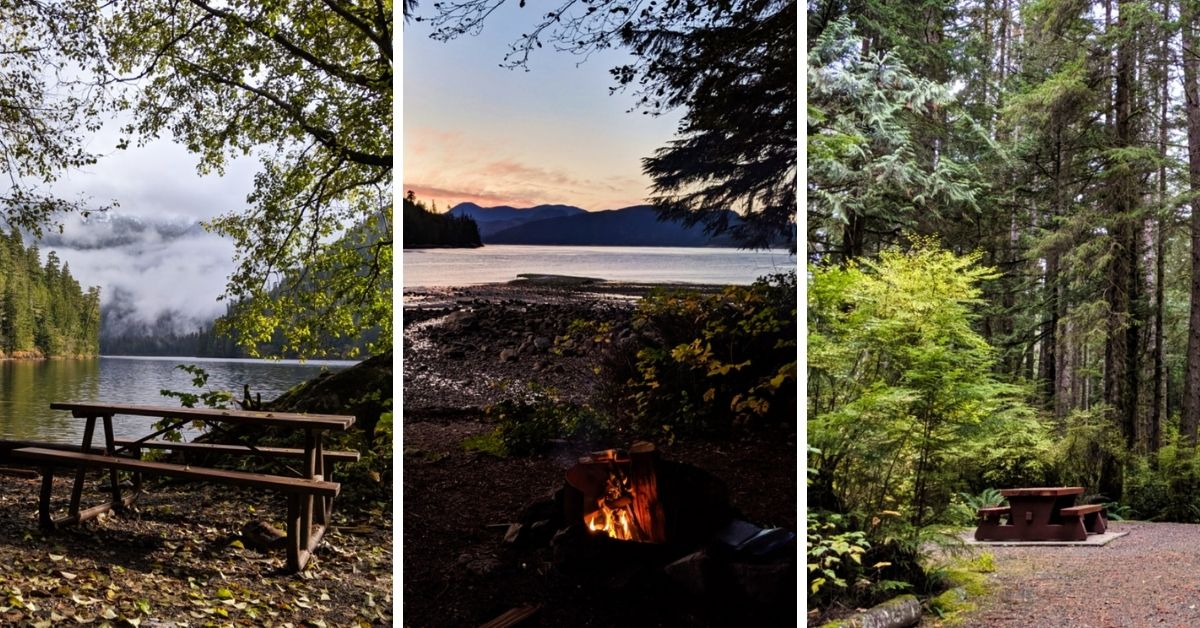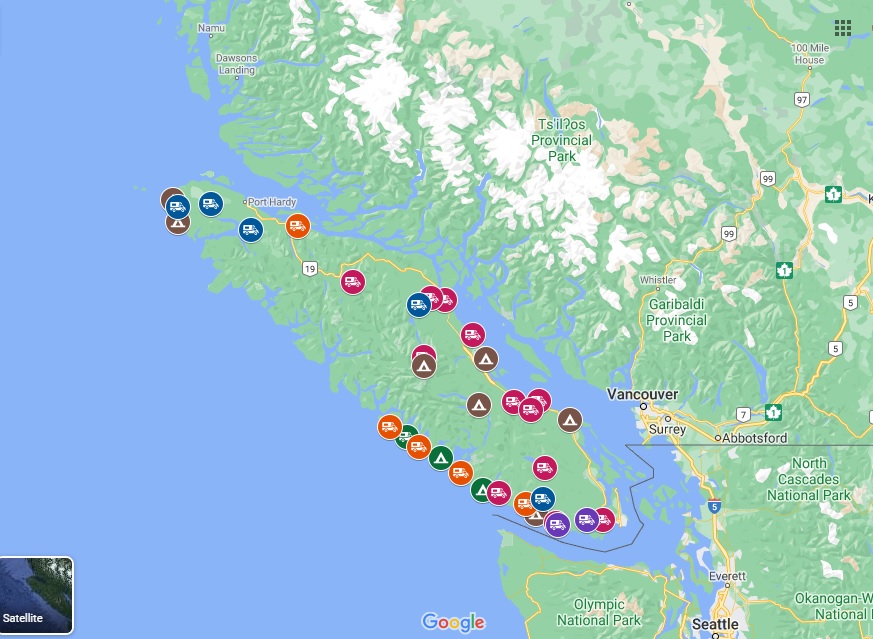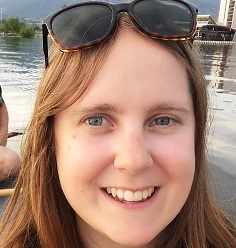Separated from the British Columbia mainland by the Salish Sea, Vancouver Island should be a top destination for anyone who loves nature.
Imagine spectacular sandy beaches, gigantic old growth trees, perennially snow capped mountains, deep canyons, thundering waterfalls and more!
The best way to truly experience this magnificent scenery, in my opinion, is to spend time right in the midst of it! For that reason, Vancouver Island is the perfect place to go camping.
With Vancouver Island being larger than most would assume (460km long and 100km wide, with over 3000km of coastline!), camping is also a very cost effective way to travel and explore this beautiful place.
The first peoples of Vancouver Island are the Coast Salish, Nuu chah nulth and Kwakiutl. The campgrounds mentioned within this post are located on the traditional territory of the 53 First Nations of Vancouver Island.
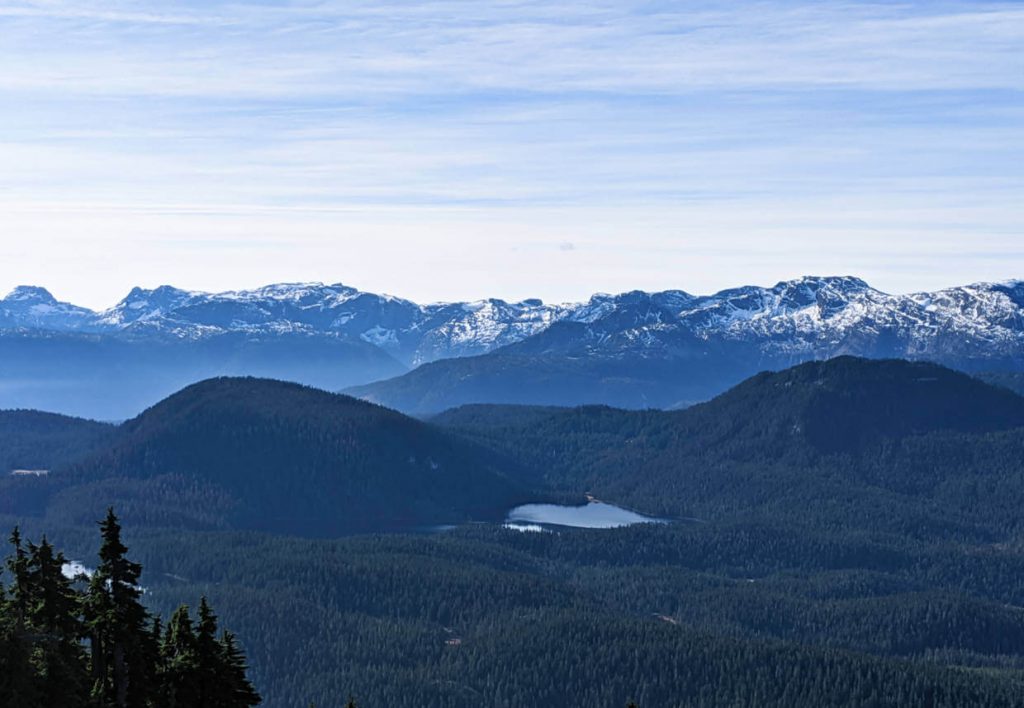
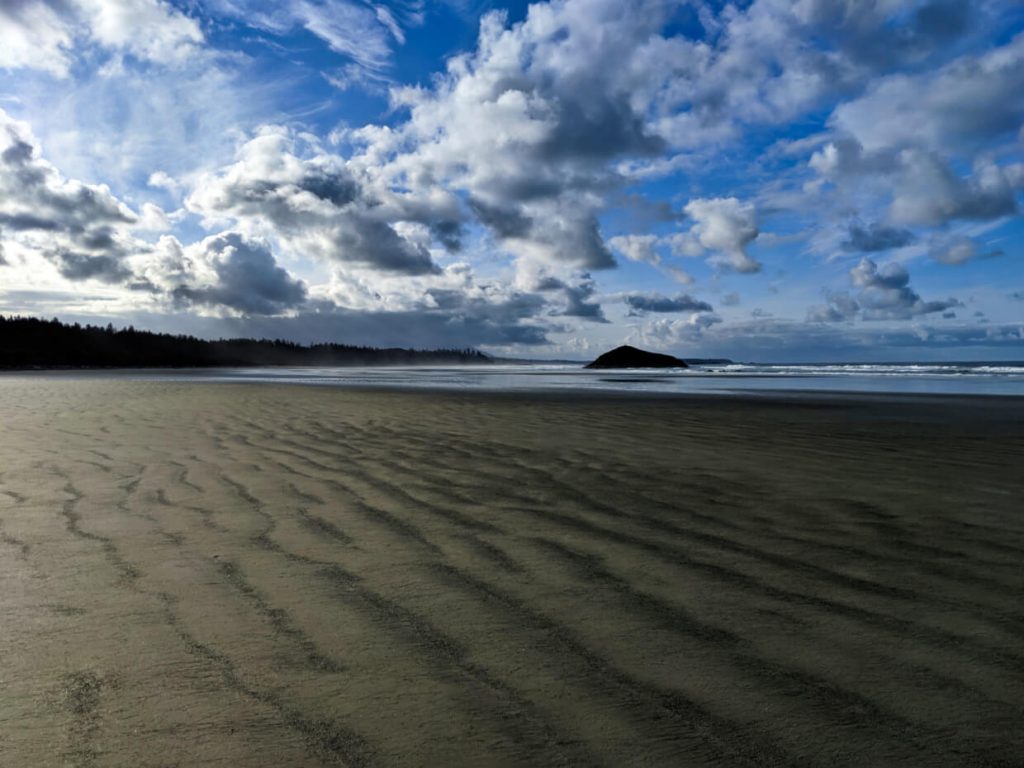
Camping on Vancouver Island
This post will features what I believe to be the best places to go camping on Vancouver Island, plus essential information about when to go, free camping options, what NOT to do and insider tips to help you secure your perfect campsite.
My partner and I have spent more than 120+ nights camping on Vancouver Island, visiting each one of these recommendaded campsites personally.
Previously living in the Comox Valley, we spent almost every weekend camping around the island. Last year, we travelled 2500km around Vancouver Island to revisit our favourite spots and discover new ones.
This post was originally published on offtracktravel.ca. The text below includes affiliate links. If you make a purchase via one of these links, I may receive a percentage of the total sale.
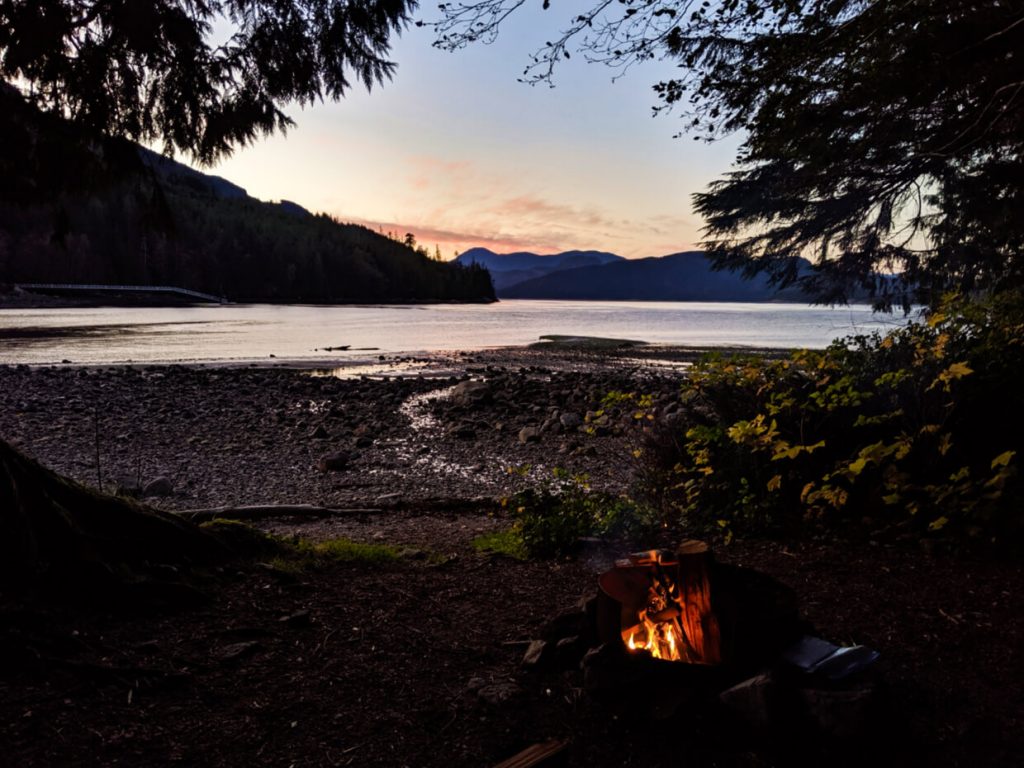
The Best Time to go Camping on Vancouver Island
Vancouver Island has some of the most pleasant year round weather in Canada, with mild (but wet) winters and sunny, usually hot, summers.
- The main Vancouver Island camping season is mid-May to early October. Most provincial park, private and municipal campgrounds will be open for the full length of this season
- Peak season is generally considered to be mid-June to early September, but this does vary with location. Private campgrounds usually charger higher fees during peak season
- Out of season, many private and provincial park campgrounds will be closed with a locked gate preventing entry
- Recreation sites (except those with a caretaker) are open all year round
Camping on Vancouver Island in summer (July, August) is most favourable to experience the warmest and driest weather. Finding camping is, however, more difficult and private campgrounds are more expensive. Campfires are more likely to be banned due to wildfire risk.
May, June and September are good months for camping on Vancouver Island as the weather can often be surprisingly warm and campgrounds are much less busy. Campfires are usually possible.
Camping (even in tents) is possible in April and October, but be prepared for damp and cool conditions. Winter storms, with torrential rain and high winds, are also possible.
The coldest months are November to March, with snow in high elevation areas. Snow falls pretty inconsistently at lower elevations, but at least one big snowfall is likely at sea level at some time during the winter.
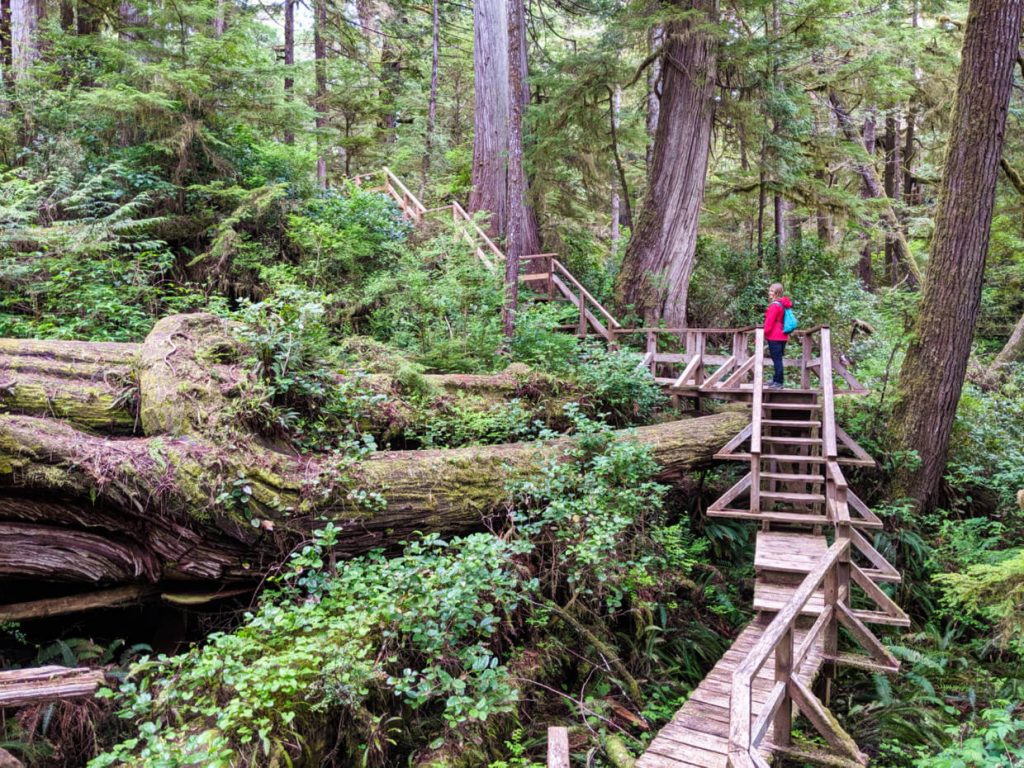
Camping on Vancouver Island: Essential Info
- When camping on Vancouver Island (or anywhere else!), it is SO important to leave no trace of your visit. This means camping on established sites, packing out everything you brought with you, only using designated rings for campfires and leaving anything you find (rocks, plants, driftwood etc)
- Keep a BARE campsite at all times to avoid attracting wildlife (including bears). ALL food and food related items should be in your vehicle or storage lockers/caches when not in use. This includes items used in food preparation such as cools, stoves, garbage etc
- Be sure to check for any campfire restrictions before heading out. The BC Wildfire Service website has all of the latest updates. Keep campfires small (0.5m x 0.5m), never leave a campfire unattended and always extinguish the fire properly after use
- If potable (drinking) water is not available, be sure to treat any natural sources of water before using. For large amounts of water, we use a Katadyn Base Camp Pro Filter. For smaller amounts, we like the BeFree filter and Aquatabs
- When leaving main roads and population centres, be sure to tell a friend or family member where you’re going and when you plan to come back. Cell service is limited in rural areas
- Local residents of Vancouver Island include black bears, cougars, elk, wolves and other large wildlife. Knowing how to stay safe around these animals (and how to keep them safe too!) is so important, especially when camping
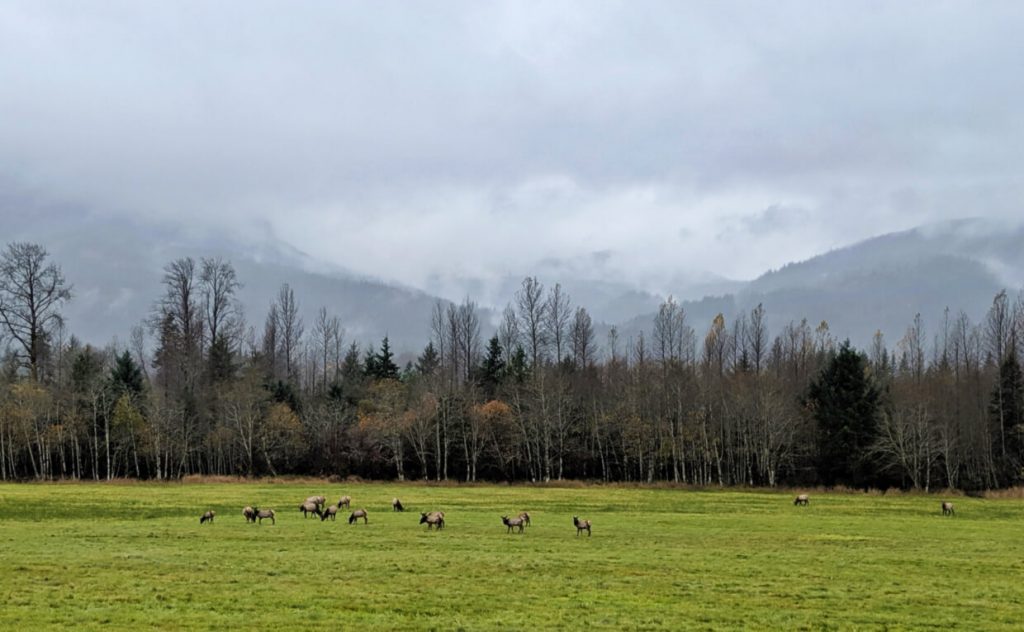
The Best Campgrounds on Vancouver Island
And finally, here is the list – over 25 of my favourite places to go camping on Vancouver Island. These campgrounds range from tiny to huge and are found across the island.
I’ve separated the campgrounds by category, starting with provincial parks and ending with recreation sites.
I have made my shortlist with a focus on tent and small van friendly campgrounds. There are many ‘campgrounds’ that look more like a parking lot, designed primarily to accommodate RVs.
This is not the camping experience we look for. Indeed, we know many people feel the same and this list reflects that.
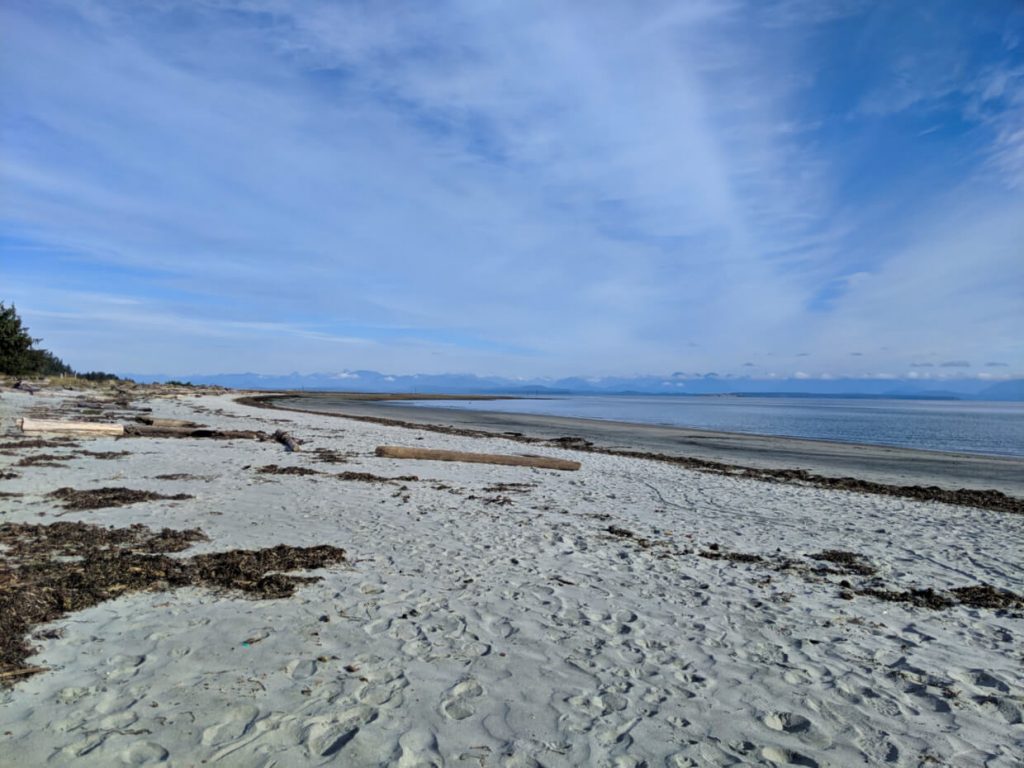
Vancouver Island camping map
Recommended campgrounds are marked on the Vancouver Island camping map below. Each campground category is marked in a different colour:
- Vehicle accessible provincial park campgrounds in maroon
- Backcountry and walk-in provincial park campgrounds in brown
- National park campgrounds in green
- Private campgrounds in orange
- Regional/municipal campgrounds in purple
- Recreation sites in blue
But wait, you missed my favourite campground?!
Sorry! With such a huge choice in places to go camping on Vancouver Island, it’s inevitable that I may not include some of your own top choices.
The list below features my personal favourites but I’m always interested in hearing about other awesome Vancouver Island camping sites!
REMEMBER: Always leave a campsite better than you found it, to ensure that future campers can enjoy their Vancouver Island camping trip too. To learn more about reducing your impact on the environment, head to our Leave No Trace guide.
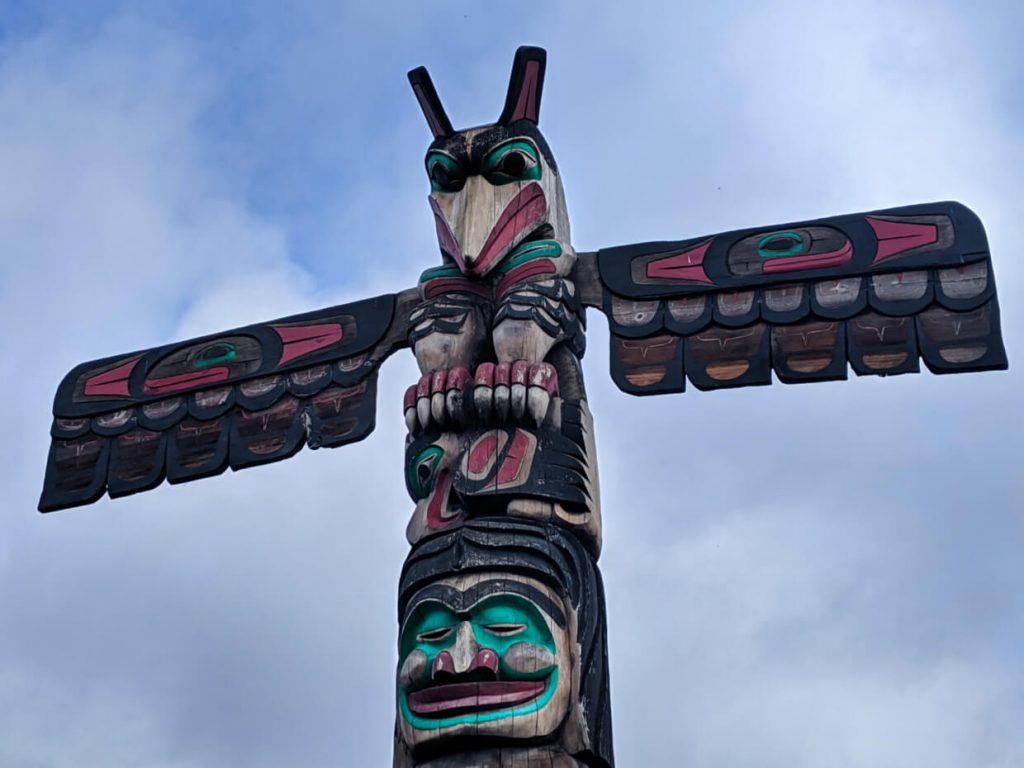
Provincial Park campgrounds – vehicle accessible
There is no doubt that provincial parks are the favoured place to go camping on Vancouver Island.
Reservations for campsites can be made up to four months in advance (based on the arrival date) and are much in demand, especially for summer weekends and holidays.
- BC’s provincial park campgrounds always feature well spaced, clean and maintained campsites with a good level of privacy
- Each campsite has a picnic table and fire ring as standard
- Most campgrounds have firewood to sell – the fee varies between parks
- None of the provincial park campground on Vancouver Island have on-site hookups for RVs
- The larger campgrounds have sani-dumps
- Reservations can be made online through Discover Camping or the BC Parks call centre 1 800 689 9025 ($5 surcharge)
For two consecutive summer seasons, I worked in the gatehouse at one of the biggest and busiest provincial park campgrounds on Vancouver Island.
Not only did this experience teach me all the ins and outs of BC Parks’ reservations and regulations (I’ve included some insider tips at the end of this post!), but I also had the opportunity to test many other Vancouver Island provincial park campgrounds. Keep reading for my top provincial park picks!
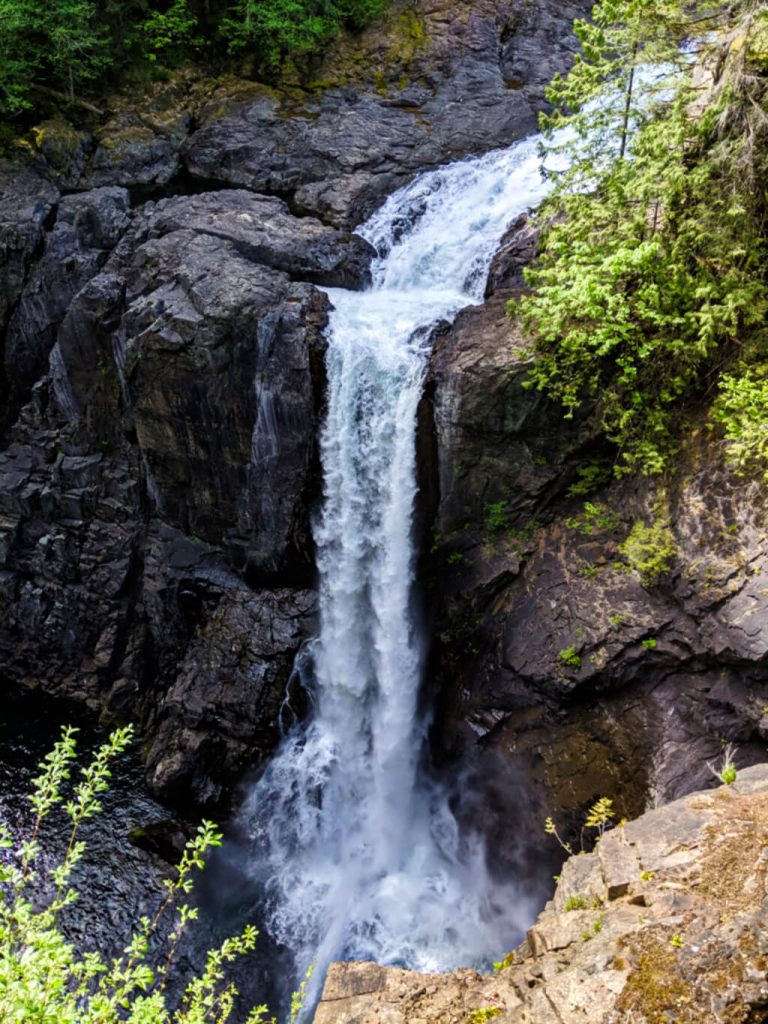
Goldstream Provincial Park
Despite being so close to Victoria, Goldstream feels like a world away. There are massive old growth trees to admire, summits to climb, waterfalls to hike to and spawning salmon to watch (in season).
The forested campground is a busy place, though it can be surprisingly quiet at the extremities. Short and long hiking trails lead from the campground to the day use areas of the park.
Goldstream has 173 vehicle accessible campsites, with 152 available for advance reservations. Campsites are $35/night per camping group in 2020. The campground has hot showers, flush toilets (as well as outhouses) and potable water. A limited number of campsites are available in the winter for $13/night (outhouses only). There is cell phone service.
China Beach Provincial Park
If you’re looking for a base from which to explore the Juan de Fuca coast (south west Vancouver Island), China Beach campground is a great option.
The well spaced treed campsites are 1km from the beach itself, accessed via a trail (steep in places and slippery after rain) through a beautiful Coastal Western Hemlock forest. The expansive sandy beach has cliff waterfalls, plenty of driftwood and panoramic views.
China Beach has 78 vehicle accessible campsites, with 66 available for advance reservations. The campground has outhouses and taps with potable (drinking) water. There is no cell service. Campsite fees are $20/night per camping group in 2020.
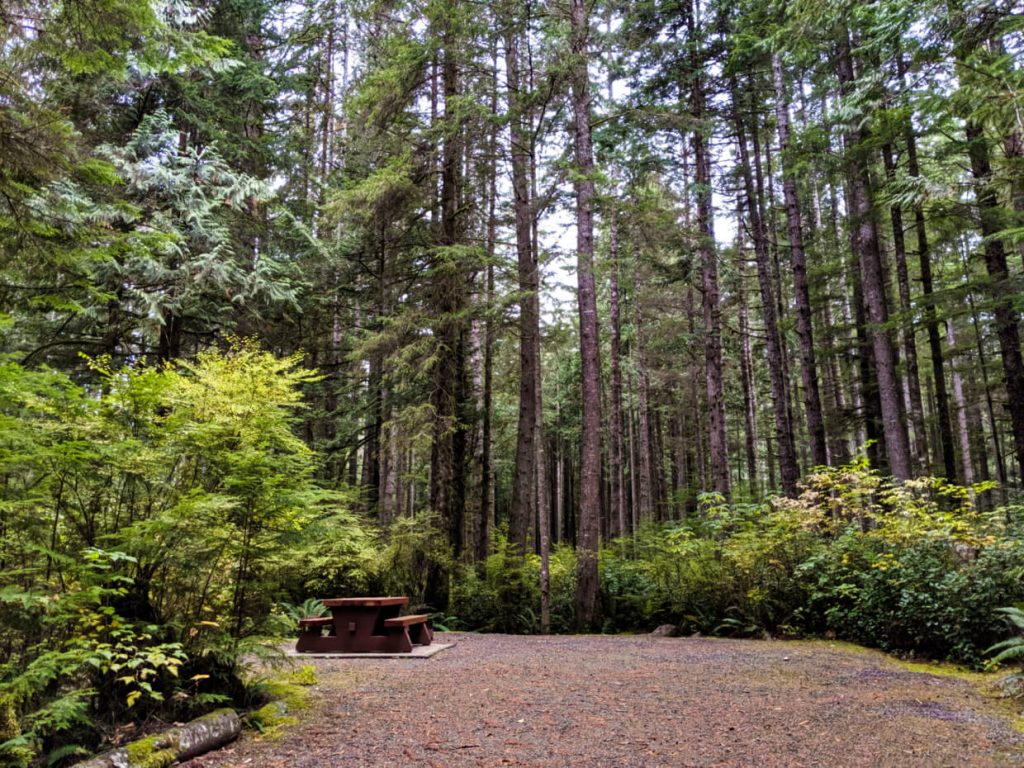
Gordon Bay Provincial Park
A little off the tourist path, Gordon Bay campground is only a short walk away from pretty Cowichan Lake.
The lake itself (one of the largest on Vancouver Island) is bordered by a large sandy beach, making Gordon Bay an awesome location for swimming, sunbathing and paddling. The reasonably large campground is set into a set in a second-growth Douglas fir stand.
Gordon Bay has 126 vehicle accessible campsites with 123 available for advance reservations. The campground has flush toilets, outhouses and taps with potable water. There is no cell service. Campsite fees are $35/night per camping group in 2020. A limited number of sites are open in winter for $13/night (no water, no flush toilets).
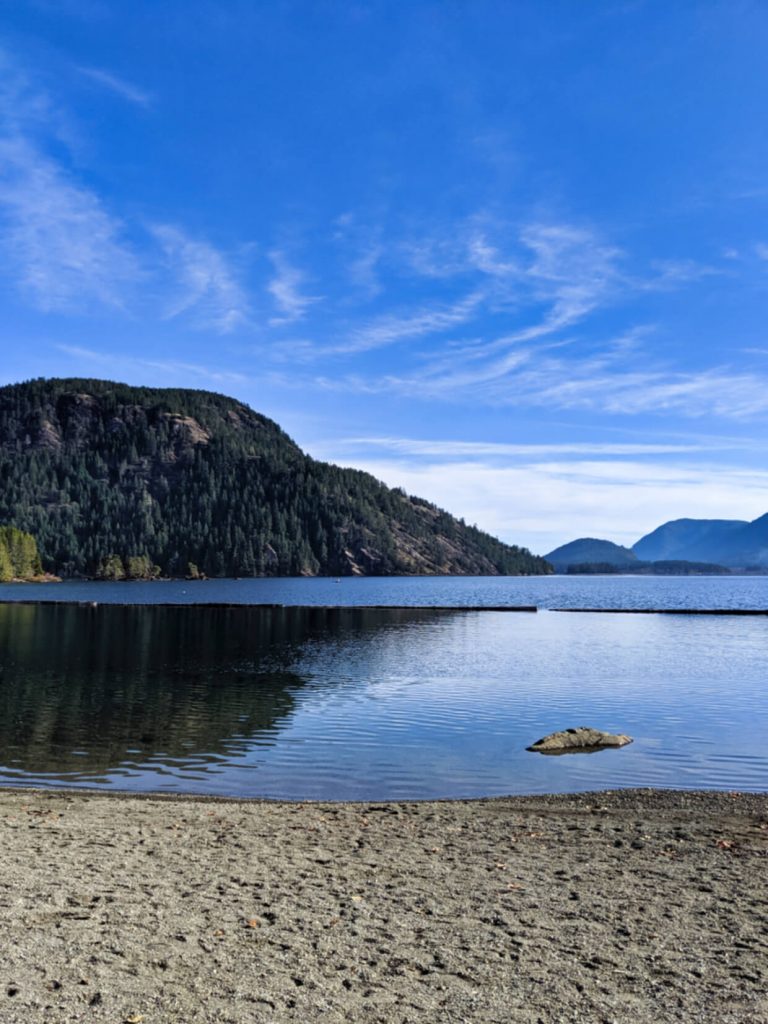
Englishman River Falls Provincial Park
Set close to two powerful dramatic waterfalls, this campground is an ideal overnight camping spot for travellers heading further north or across to the west coast of Vancouver Island.
Easy hiking trails lead from the Englishman River Falls campground through second and old growth forests to the dramatic waterfalls, canyon and stunningly clear pools. Swimming is allowed in the river below the lower falls.
Englishman River Falls has 104 vehicle accessible campsites with 72 available for advance reservations. The campground has outhouses and potable water taps. There is limited cell service here. Campsite fees are $23/night per camping group in 2020.
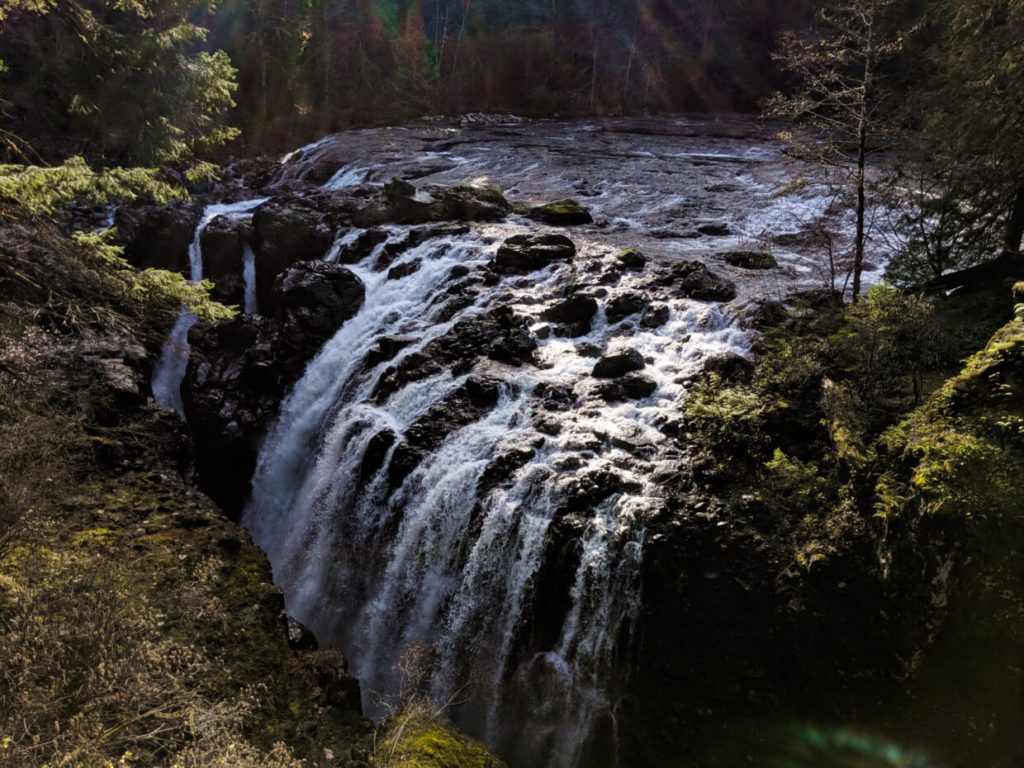
Rathtrevor Beach Provincial Park
Rathtrevor Beach is one of the most popular places to go camping on Vancouver Island. And it’s so easy to see why – most of the spacious campsites are less than five minutes walk from a gorgeous, wide sandy beach.
Look for crabs, sand dollars and bald eagles while admiring the panorama of snow capped mountains across the Salish Sea. Scattered with huge Douglas Fir trees, the forested campground has plenty of shade on sunny summer days.
All of the 250 vehicle accessible campsites at Rathtrevor Beach are reservable. Campsite fees are $35/night per camping group in 2020. In addition, Rathtrevor has 25 walk-in tent campsites (also reservable) available for $22/night. There are hot showers, flush toilets, outhouses, potable water taps and cell service. Limited sites are open in the winter at $13/night (outhouses only).
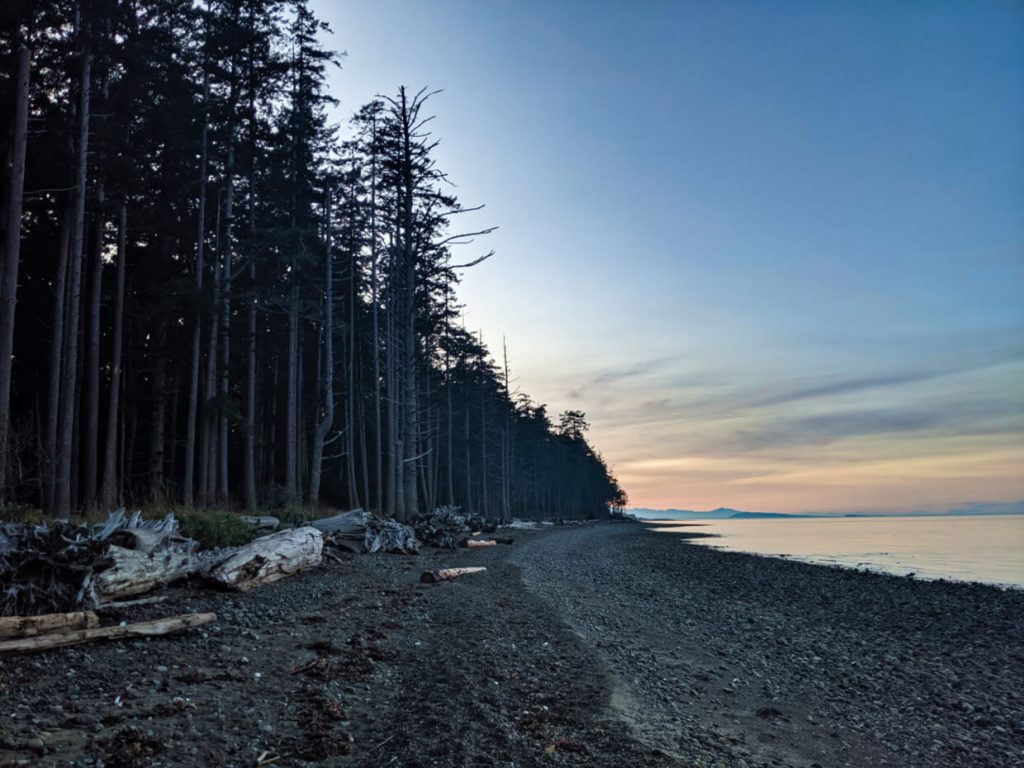
Little Qualicum Falls Provincial Park
An ideal stopover point when travelling between Victoria and Tofino, Little Qualicum Falls campground is shady and usually quiet.
Hiking trails meander through old and second growth forest to the cascading waterfalls that give the park its name. The Lower Campground is reopening in 2020 after winter storm damage caused it to be closed for one season.
Little Qualicum Falls has 96 vehicle accessible campsites with 81 available for advance reservations. The campground has outhouses, flush toilets and potable water taps. There is cell service here. Campsite fees are $23/night per camping group in 2020.
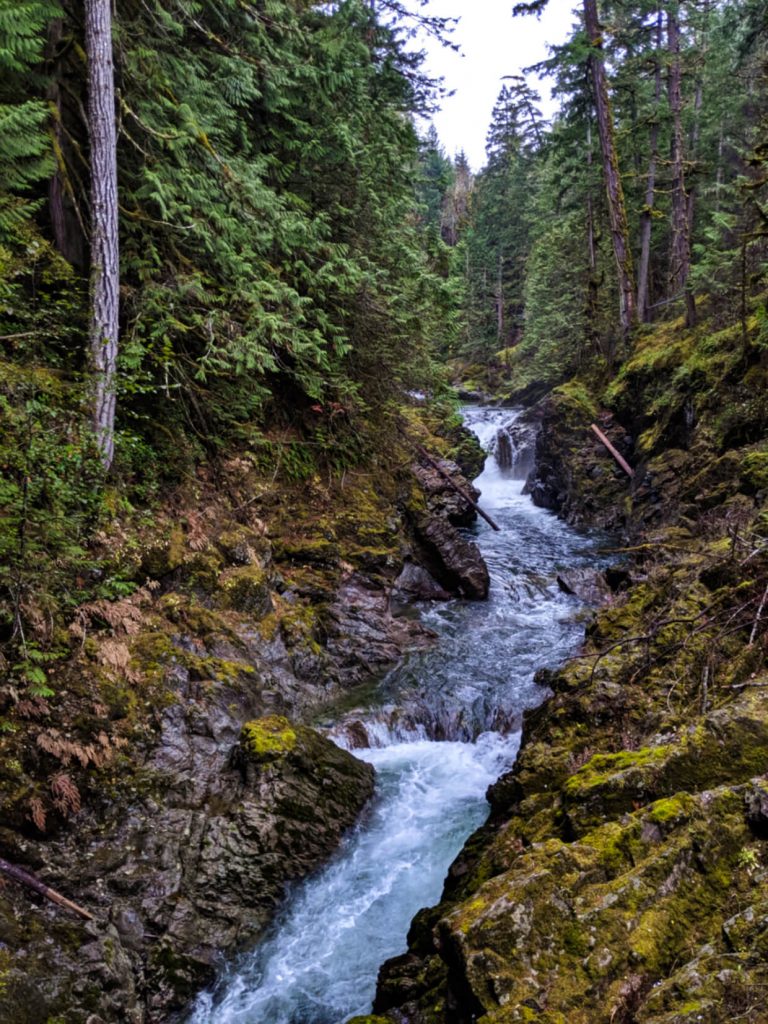
Kitty Coleman Provincial Park
One of the best kept Vancouver Island camping secrets, volunteer-run Kitty Coleman offers incredible oceanfront camp spots with an unbelievably low price tag.
There may be less privacy here than at other provincial parks but the amazing Salish Sea views just can’t be beaten. Even better still, these fabulous campsites are all available on a first come, first serve basis!
Besides walking on the beach, it is also possible to fish, swim and admire a huge 500+ year old Douglas Fir tree.
Kitty Coleman has 65 vehicle accessible campsites. There are outhouses and potable water taps. The camping fee is $15/night. There is no reservation system, but you can call the caretaker (250 338-1332) to check how many sites are currently available. The maximum length of stay at Kitty Coleman is 10 days. There is cell service here.
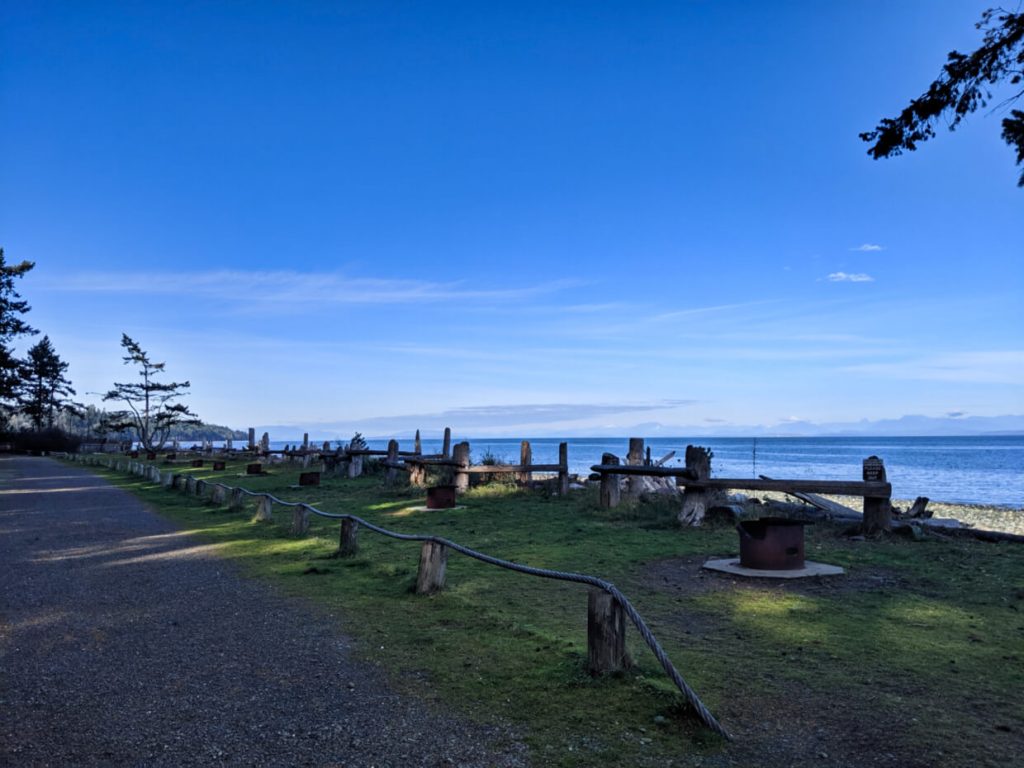
Quinsam, Elk Falls Provincial Park
Quinsam campground is located a very short drive from Campbell River, making it the ideal base for exploring the ‘gateway’ of North Vancouver Island.
Most of the campsites are set into the sun-dappled second growth forest, but some sit right next to the relaxing Quinsam River.
Taking a trip to nearby Elk Falls from the campground is a must – dramatically cascading into a deep canyon, this 25 metre waterfall is one of the most impressive on Vancouver Island. A suspension bridge offers incredible views.
Quinsam campground has 122 vehicle accessible campsites, with 70 available for advance reservations. There are flush toilets, outhouses and potable water taps. There is cell service here. Campsite fees are $22/night per camping group in 2020. Limited sites are open in the winter at $11/night (outhouses only).
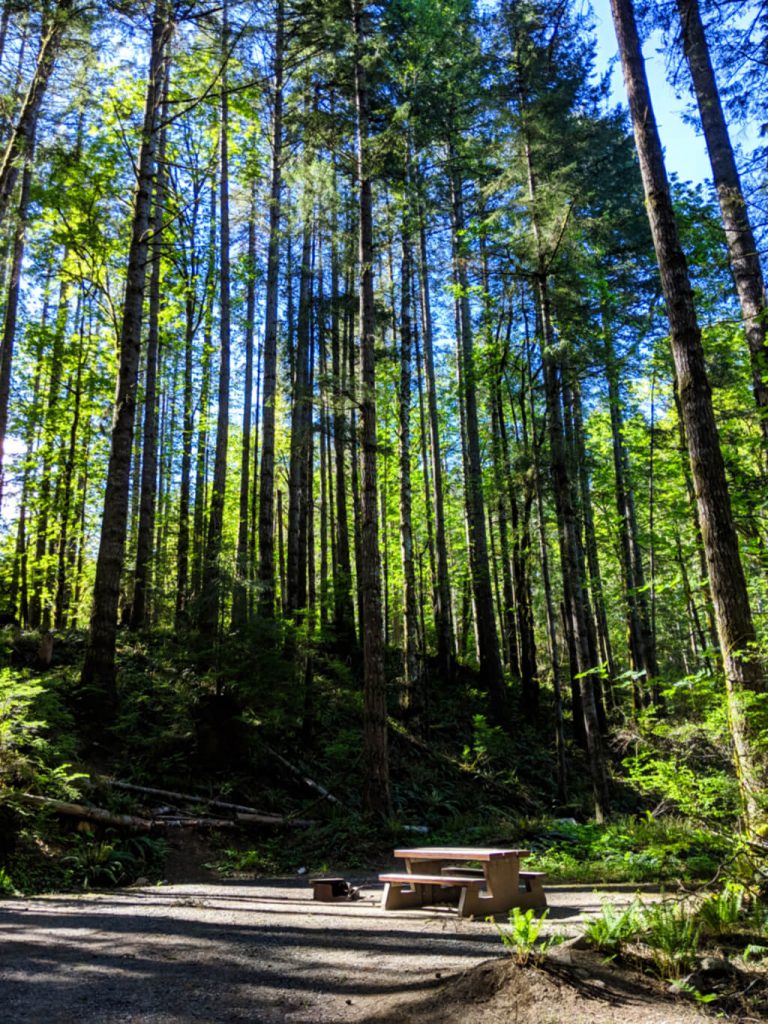
Loveland Bay Provincial Park
Accessed via a gravel road, Loveland Bay offers a taste of the beautiful Sayward Forest. All of the campsites here are located along Campbell Lake, a huge body of water that is part of the Sayward Forest Canoe Circuit.
Swimming is a very popular activity at this campground, with the lake warming up fairly quickly in summer.
Loveland Bay has 31 vehicle accessible campsites, with 28 available for advance reservation. There are outhouses around the campground and potable water is available. Campsite fees are $22/night per camping group in 2020. There is no cell service here.
Ralph River, Strathcona Provincial Park
Ralph River is a peaceful spot to be based, towards the southern end of Buttle Lake in Strathcona Provincial Park. The campground itself is set by the lake and sites lie under the canopy of an impressive old growth Douglas Fir forest.
The other vehicle accessible drive-in campground in Strathcona Park is Buttle Lake, situated 28km north of Ralph River. It has 85 sites (17 are first come, first serve) and a sandy beach. I prefer Ralph River as it is quieter and more spread out.
Ralph River has 75 vehicle accessible campsites, with 41 available for advance reservation. There outhouses and hand pumps (with potable water) located around the campground. Campsite fees are $20/night per camping group in 2020. There is no cell service here.
Schoen Lake Provincial Park
Small but mighty, Schoen Lake campground has magnificent views across the pristine water to 1,802 metre rugged Mount Schoen.
This campground is firmly away from the beaten path, with very few facilities offered and a narrow (bumpy at times) access road. Best suited for paddlers and adventurous travellers looking for a taste of true Vancouver Island wilderness.
Schoen Lake has 9 vehicle accessible campsites, all available on a first come, first serve basis only. There are two outhouses located at the entrance of the campground. Campsite fees are $11/night per camping group in 2020. There is no cell service here
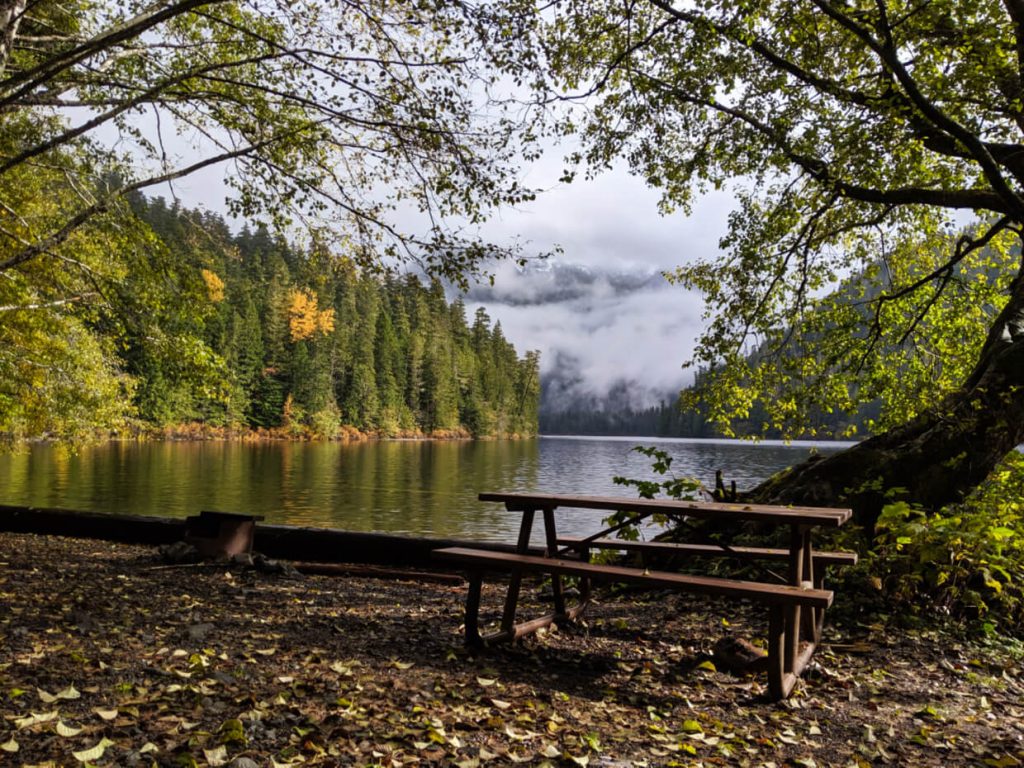
Provincial Park campgrounds – walk-in and backcountry
Vehicle accessible campgrounds in provincial parks are known to be in the ‘frontcountry.’
Provincial park areas accessible only by water or foot are accordingly called ‘backcountry’ and offer many more camping opportunities for adventurous self-sufficient campers.
Most of the backcountry campsites on Vancouver Island operate on a first come, first serve system.
Also in this category, I’ve included campgrounds that are ‘walk-in’ access only, meaning that there is a short walk (or ferry in one case!) required to reach the campsites.
Juan de Fuca Provincial Park
Home of the 47km Juan de Fuca Marine Trail, this provincial park provides spectacular coastal day hiking and backpacking opportunities.
Despite being shorter, the Juan de Fuca Trail is often described as being just as difficult as the more famous West Coast Trail. Much like the WCT, it offers impressive ocean views, challenging hiking conditions (mud, fog, high tides, rocks) and secluded beach camping.
Visitors who do not want to hike the entire trail can access the coast at several different points – China Beach, Sombrio Beach, Parkinson Creek and Botanical Beach.
There are no reservations required to hike the multi-day Juan de Fuca Marine Trail, though there is a $10/person/night backcountry use fee payable at trailhead deposit boxes. There are seven designated camping areas located along the route, with most offering beach tenting spots, outhouses and bear caches. The trail is open year round. There is no cell phone service.
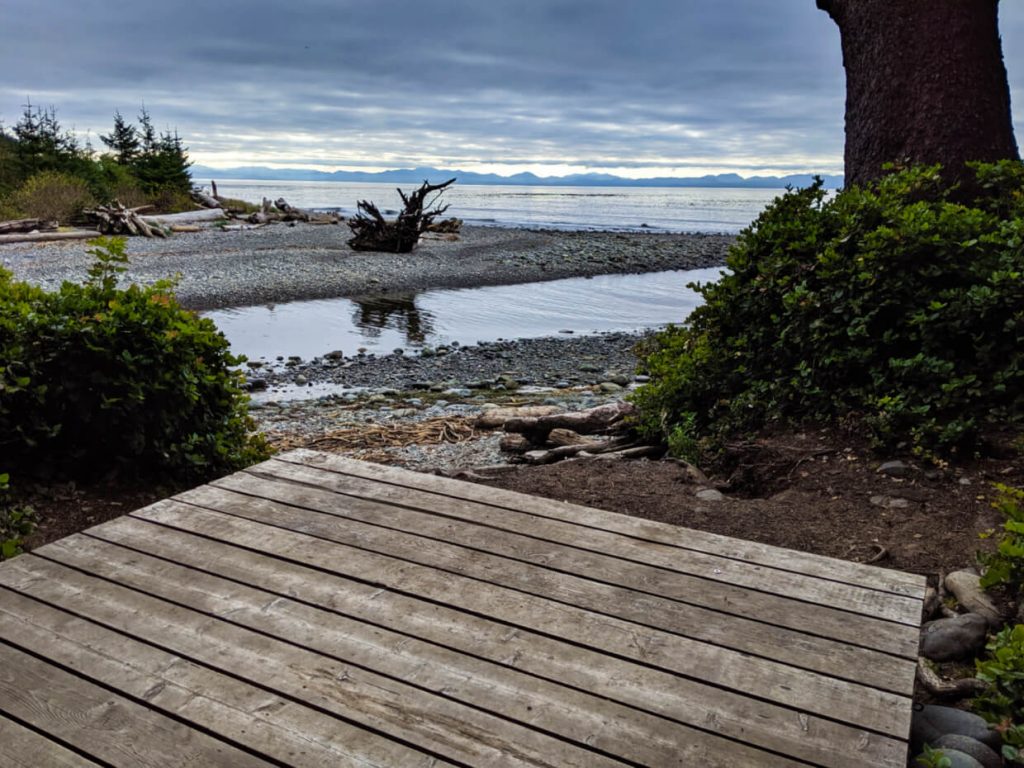
Sproat Lake Provincial Park
For those looking for a simple Vancouver Island camping experience, Sproat Lake may be the answer.
As well as two vehicle accessible campgrounds, this park has a handful of walk-in campsites located very close to the lake. They are just a short walk from the prehistoric petroglyphs that make Sproat Lake famous.
Set into a forest, the campsites don’t have a lot of privacy but the convenience and location are worth the sacrifice.
Sproat Lake has 5 walk-in campsites. All are first-come, first-serve. The camping fee is $25/night. There are flush toilets, outhouses, potable water taps and showers. There is cell phone service here. Sproat Lake also has two vehicle accessible campgrounds, with the ‘Lower’ one being closer to the lake. Campsites here are also $25/night.
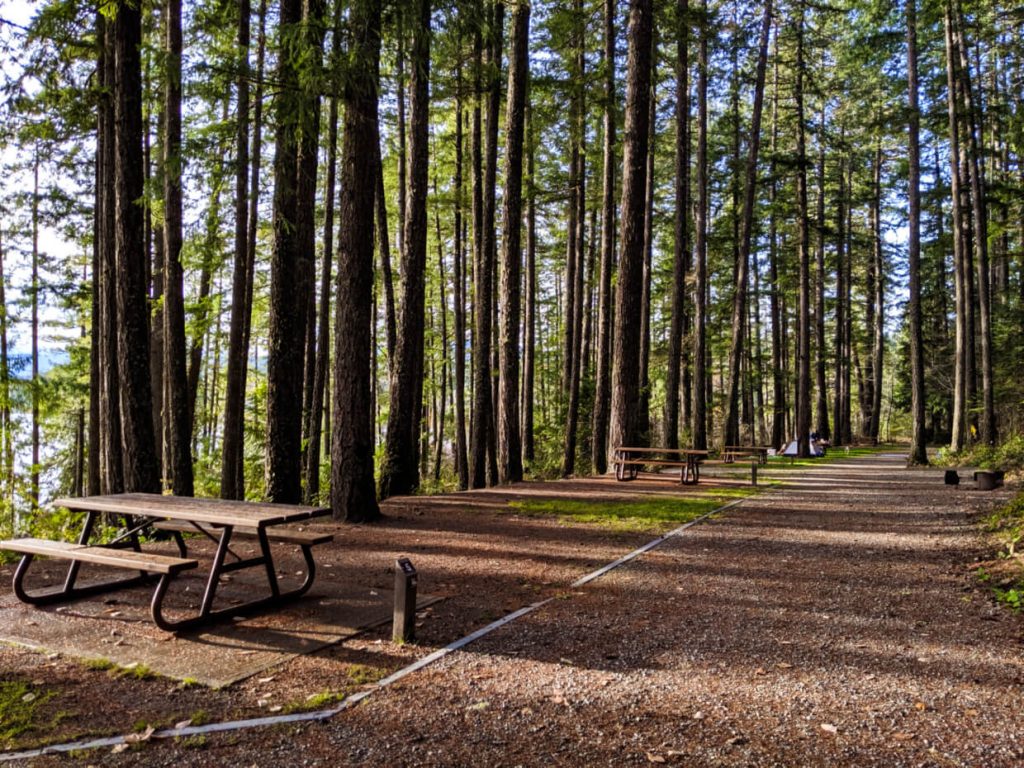
Saysutshun Marine Provincial Park (aka Newcastle Island)
Located just across the water from downtown Nanaimo, the island of Saysutshun (Newcastle Island) was once host to two Salish villages. It later became the base of a fish-salting operation, sandstone quarry, shipyard and pleasure resort.
Nowadays, it’s a relaxing place to explore by foot or bike. Accessible via a private boat or 10 minute regularly scheduled passenger ferry, the small forested campground on Newcastle Island is only five minutes walk from the dock.
Saysutshun has 18 walk-in campsites, all available for advance reservations. There are outhouses, potable water taps and a flush toilet building with coin operated showers. Campsite fees are $18/night per camping group in 2020. There is cell phone service here.
Strathcona Provincial Park
Located right in the middle of Vancouver Island, British Columbia’s first provincial park has an abundance of nature and outdoor adventure to reward curious travellers.
Mountain peaks dominate, but hikers can also admire glaciers, fjord-like valleys, high elevation lakes, alpine meadows and Canada’s highest waterfall, Della Falls (click here to read about our adventure to see it).
This massive protected area (over 248,669 hectares) is host to numerous wilderness camping areas, with designated backcountry sites on the Bedwell Lake Trail, Elk River Trail, Della Falls Trail as well as the Forbidden Plateau core area.
Backcountry camping rules, regulations and facilities vary across Strathcona Provincial Park. Check the specific conditions on the BC Parks website here. Camping fees are $10/per night/per person where applicable. There is very limited cell phone service within Strathcona Provincial Park.
Cape Scott Provincial Park
Perched at the top northwestern tip of Vancouver Island, Cape Scott is a wild and rugged park featuring gorgeous white-sand beaches, old growth forest, salt marshes, wind battered headlands and fascinating history.
My favourite camping spot is Nels Bight, a wide golden sandy beach stretching more than 2km. The sunsets can often be spectacular here.
From Nels Bight, you can day hike to the Cape Scott Lighthouse, Hansen Lagoon or Guise Bay (another beautiful beach). The camping on Nels Bight beah is accessible via a 26km return hike (read our hiking guide here).
For an easier alternative to Nels Bight, consider camping at San Josef Bay. The stunning beach is an easy 5km return hike from the parking lot and also features fascinating ‘flowerpot’ rock formations.
Cape Scott has six designated camping areas – Nels Bight, Nissen Bight, San Josef Bay, Eric Lake, Fisherman River and Guise Bay. The backcountry camping fee is $10/per night/per person. The trail is open year round but adverse weather conditions over winter can make camping difficult.
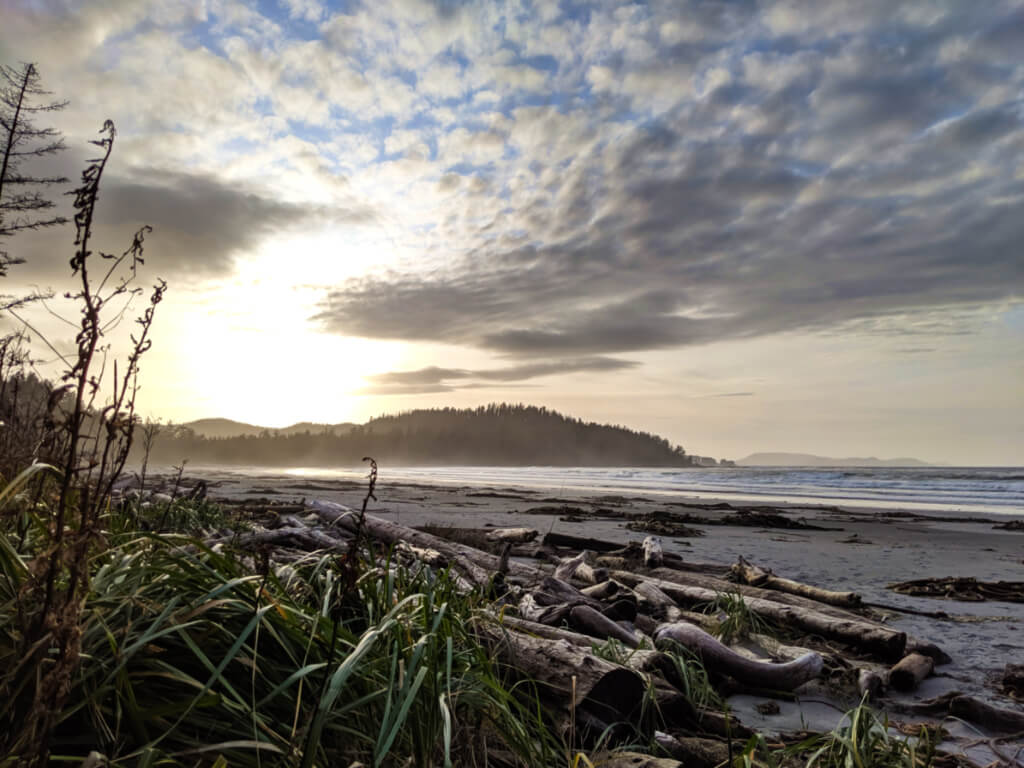
Raft Cove Provincial Park
Located just a little further south, Raft Cove offers a similar Vancouver Island camping experience to Cape Scott.
Camping on the windswept white sand beach can be an incredible wilderness experience, despite being relatively so close to a road. The 2km trail to the beach should not be taken lightly however, as the path is exceptionally muddy and rooty.
Raft Cove has backcountry camping available both on the beach and in the (more sheltered) forest behind.
The main camping area is at the far end of Raft Cove (tent pads, new outhouses, food caches) but there are a couple of smaller sites with food caches and outhouses marked with colourful buoys located along the way.
The camping fee is $5/per night/per person payable via the BC Parks Backcountry Registration System.
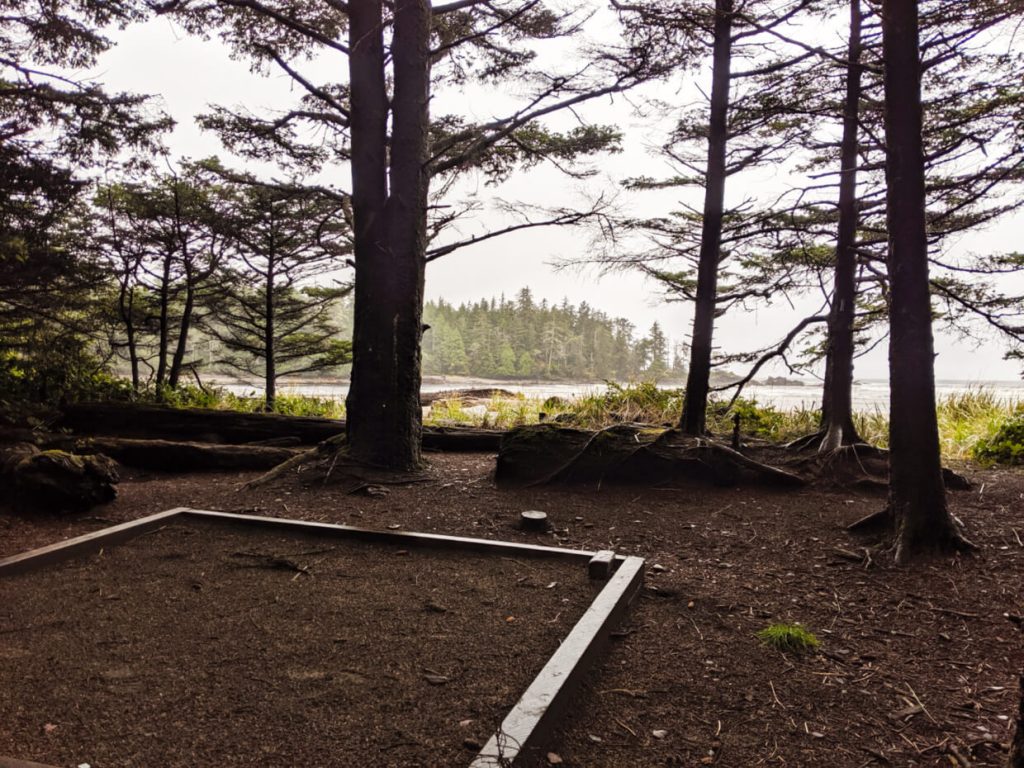
National Parks
Vancouver Island is home to Pacific Rim National Park. The park consists of three areas (or ‘units’) – Long Beach, the Broken Group Islands and the West Coast Trail.
Long Beach has a vehicle accessible campground (Green Point) while the other the Broken Group and West Coast Trail offer backcountry camping only.
Reservations open for all Pacific Rim campsites open in early January for the following summer season and can be made online via the Parks Canada Reservation Service or by calling 1-877-737-3783.
To visit or stay overnight in Pacific Rim National Park, you’ll need to pay the daily entrance fee ($10/day for adults) OR have a valid Discovery Pass.
Green Point Campground
The one and only vehicle accessible campground in Pacific Rim National Park, Green Point is located on a forested bluff above magnificent Long Beach.
Most of the well spaced camp spots are surrounded by forest, with some of the oceanside sites having ‘peek through’ views of the beach. Campers can access the golden sands of Long Beach via a short (5 minute) downhill trail.
Green Point Campground has 94 vehicle accessible campsites and 20 walk-in tent sites, available from May to October. Drive-in sites have electrical service and access to showers and flush toilets, as well as outhouses. There is potable water available and firewood for a fee.
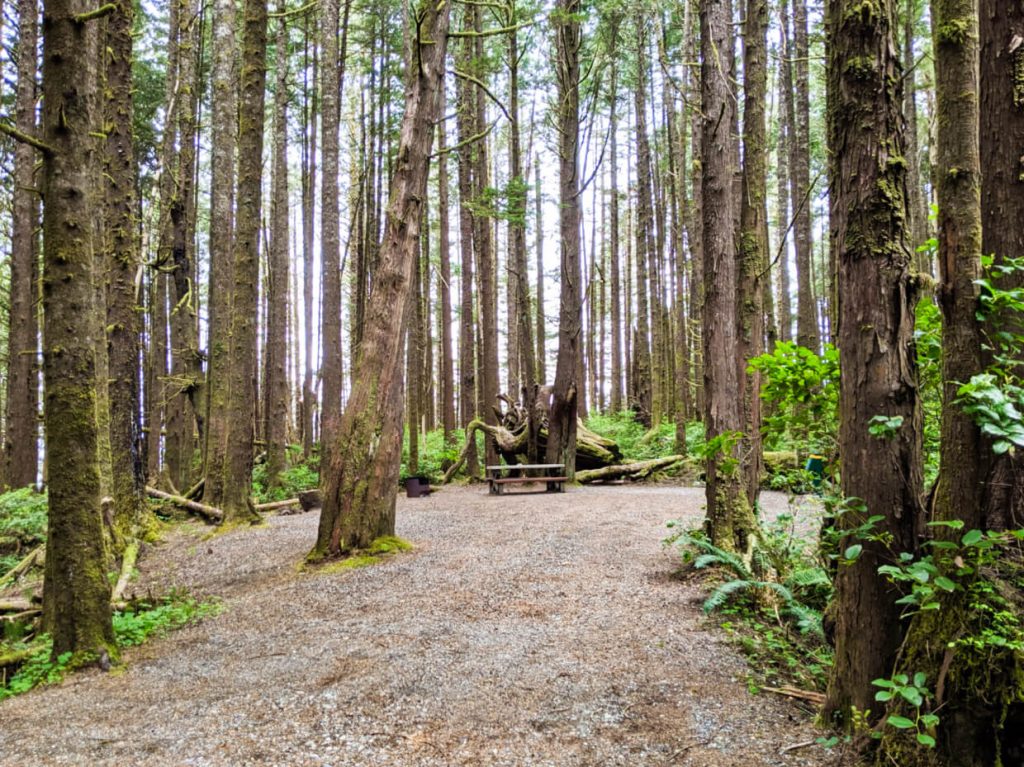
West Coast Trail
The West Coast Trail is an iconic multi-day hiking adventure along the rugged Pacific coastline.
The 75km long trail (plan for 6-8 days) has an fascinating history. It was created first as a trade and travel route for Huuay-aht, Ditidaht, and Pacheedaht First Nations and later also used as a lifesaving path for shipwrecked sailors and their rescuers.
Open from May to October each year, hikers camp on beautiful sandy beaches, next to creeks or under the canopy of the temperate rainforest.
Only a limited number of hikers are allowed to start the West Coast Trail every day. Reservations are snapped up very quickly for the north and south trailheads. There is a standby list at each trailhead in case of no-shows, but the wait can be very long (two or more days).
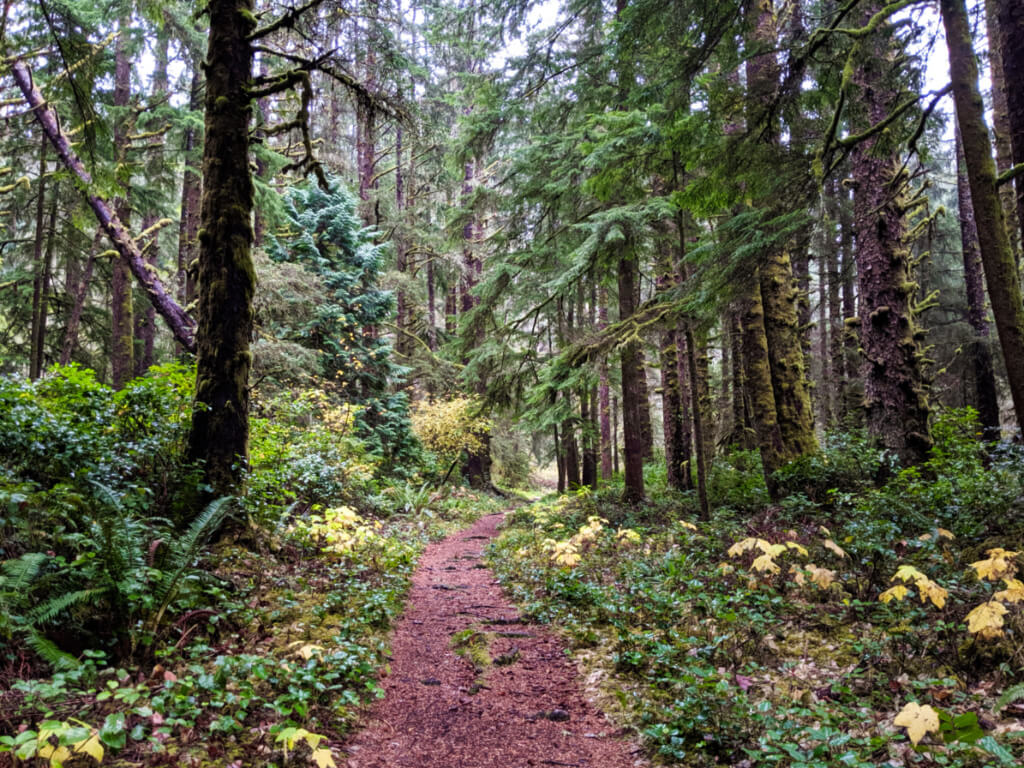
The Broken Group Islands
The Broken Group Islands are a paddler’s paradise – a marine archipelago of small islands, reef, channels and bays with an incredibly rich inter tidal zone.
Designated camping areas are situated on seven different islands and can only be accessed by boat.
There are kayak tour operators offering trips to the Broken Group for visitors without kayaking experience and/or required equipment.
Camping spots in the Broken Group Islands are available only through the reservation system. Popular dates (July, August, holidays) are claimed fast, so be sure not to miss the early January opening date or consider planning a trip in the shoulder season instead (May, June, September).
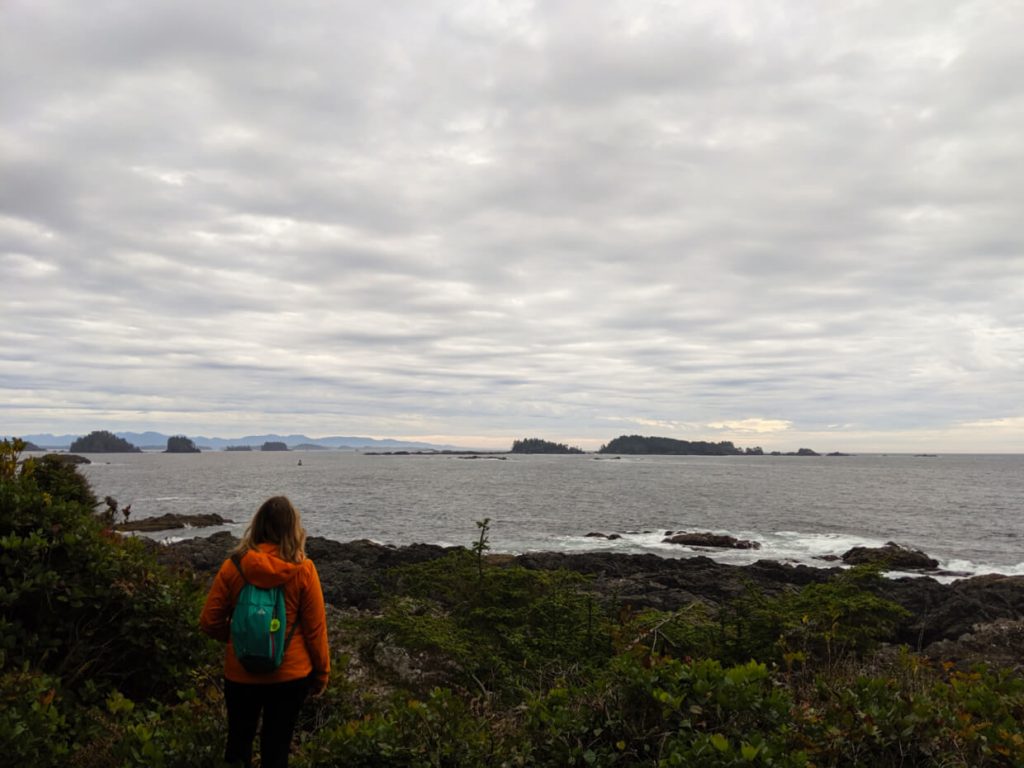
Regional/Municipal Campgrounds
These campgrounds offer a mix of provincial park maintenance with recreation site casualness.
My top picks (listed below) both use a first come, first serve system for allocating campsites, which is very helpful for spontaneous campers or anyone who is just travelling through the area.
Spring Salmon Place Campground, Sooke Potholes Regional Park
Formed millions of years ago after the last ice age, the Potholes are a unique geological formation of deep rock pools, waterfalls and canyons.
The Spring Salmon Place Campground is located in a quiet and secluded sport at the north end of the potholes with swimming, hiking and biking opportunities.
Spring Salmon Place has 67 campsites, all offered on a first come, first serve system. There is potable water and outhouses in the campground. Cell phone service is limited. Campsite fees are $25/night per camping group in 2020.
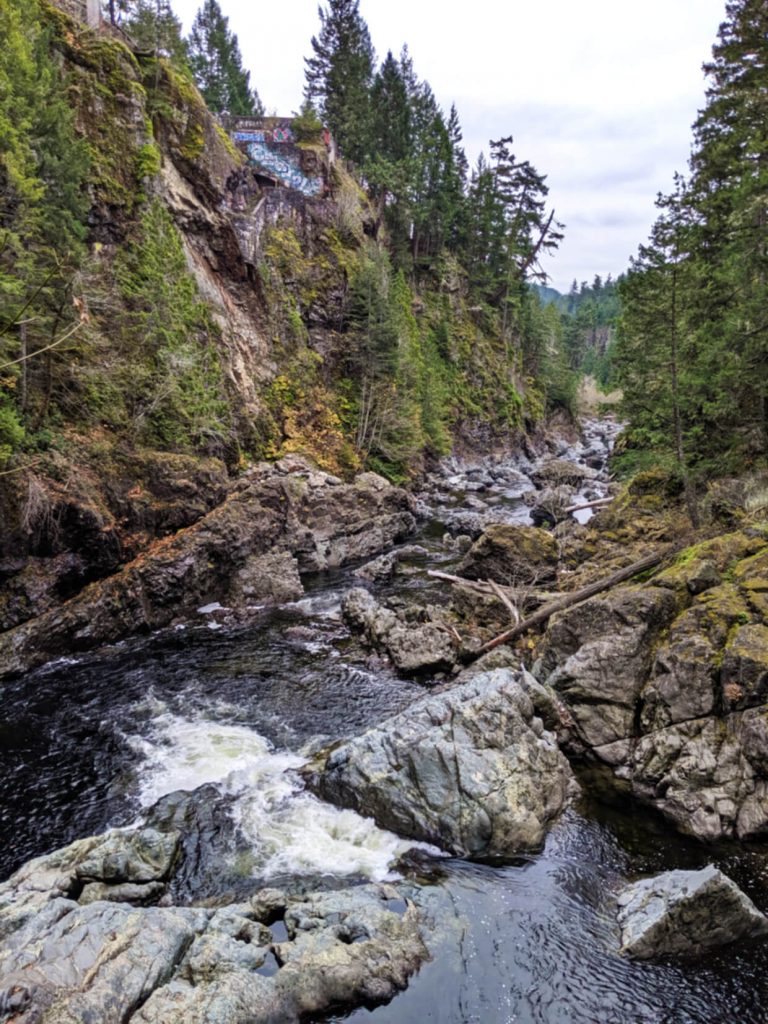
Jordan River Regional Park Campground
One of my favourite spots on the whole of Vancouver Island, this understated campground has oceanfront camping on the Juan de Fuca strait, with views across to the Olympic Peninsula (Washington, USA).
While most of the campsites do not offer a lot of privacy or shade, the location is absolutely stellar, especially for the price!
Jordan River is just over an hour from Victoria and makes for a great base from which to explore the excellent hiking in the area (Sandcut Beach, East Sooke Regional Park, Juan de Fuca Provincial Park).
Jordan River Regional Park Campground has 15 vehicle accessible campsites and 7 walk-in sites (some of the latter are currently shut to invasive plant management). All sites are allocated on a first come, first serve system. There are outhouses and a drinking water station. Campsite fees are $15/night per camping group during summer and $10/night from Nov-May. No cell phone service.
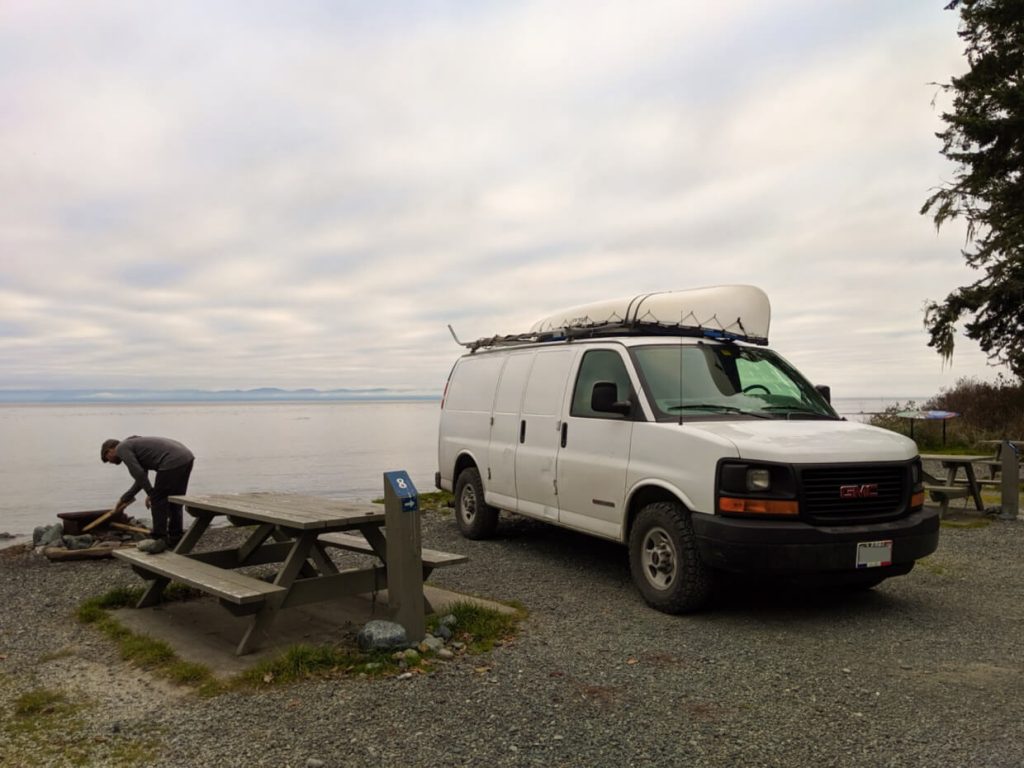
Private campgrounds
Being privately owned, private campgrounds operate a bit differently than provincial or national park campgrounds.
They usually have more emphasis on RV owners, who are more likely to want more serviced campsites with power, water and sewer hookups. Campsites are usually smaller and located closer together.
Private campgrounds typically offer more amenities such as showers, flush toilets, wi-fi and swimming pools with a higher price tag to reflect this.
We are very picky when it comes to private campgrounds. To make the cut, they have to be both tent friendly and nature focused.
So I can assure you that all of these private campgrounds on Vancouver Island have a little something special about them.
Pachena Bay Campground
The star of Pachena Bay Campground, near Bamfield, is an unbelievably stunning pristine white sand beach.
The campsites are located in the temperate rainforest just behind, on both sides of a very straight, long road. There are 8 campsites with absolute oceanfront views, though all of the shady sites are within easy access of the sand.
Just a stone’s throw from the start of the West Coast Trail, Pachena Bay has a real end of the world feel about it. The journey from Port Alberni (around 2 hours) is slow and bumpy, making this campground an appropriately climatic destination after a long drive.
Pachena Bay Campground has over 65 campsites, with the majority being tent sites. Peak season rates start at $45 and peak at $69/night with the oceanfront sites. The campground has flush toilets, potable water, 8 serviced RV sites, coin operated showers, wi-fi (at the office) and a gas station. There is limited cell phone service. Campsites can be reserved online.
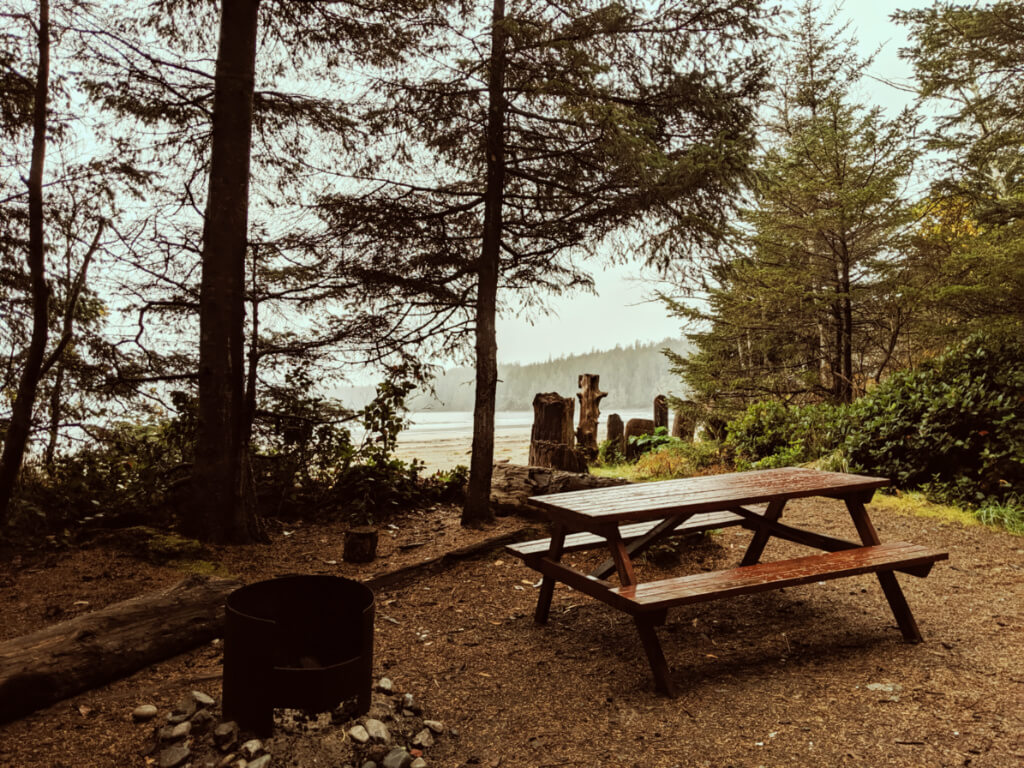
Pacheedaht Campground
Found at the southern terminus of the West Coast Trail, Pacheedaht Campground is situated on a magnificent 2km long sandy beach.
The campground is split into two main sections, with sites on the southern side being more rustic and less standardised. Some campsites are waterfront, with others set into forest or with views of the San Juan river estuary.
The organisation of this campground is on the relaxed side, so online information can be hard to find.
There was a Facebook group with a phone number listed but this is not online at the time of writing (Feb 2020). This Imgur file (from 2018) has camping prices, rules, regulations and hand drawn maps.
Pacheedaht Campground has over 65 campsites of varying sizes. The expansive campground has flush toilets, outhouses, showers and potable water. There are powered sites available. Cell phone signal is limited here.
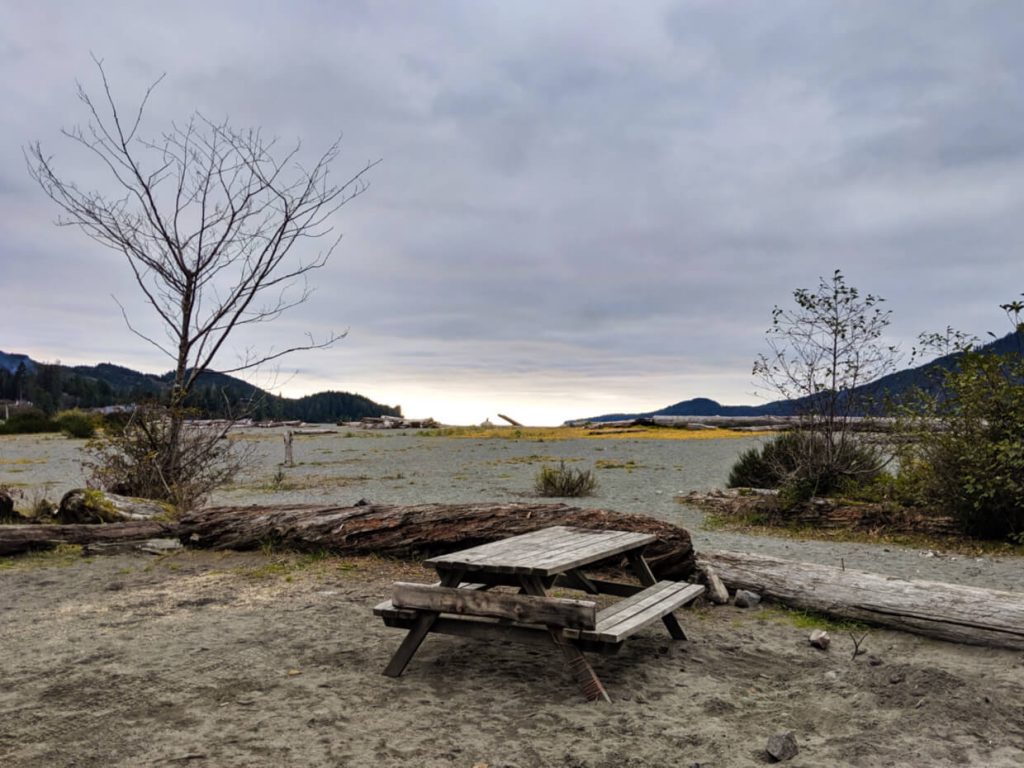
Bella Pacifica Campground
Situated right on beautiful Mackenzie Beach, Bella Pacifica is our pick for the best private campground in the Tofino area.
There’s a real mix of different sites and locations on offer, from beachfront, oceanside and forest sites. The beachfront sites lack a little privacy but the views (and the sound of the nearby ocean!) are amazing.
Some sites have services (water, power), while others are more rustic and primarily designed for tent users. Either way, all sites are a very short away from the beach and roaring Pacific ocean.
Bella Pacifica has almost 200 campsites, ranging in price from $49-60/night in peak season. Keep in mind that Tofino is one of the most expensive places to go camping on Vancouver Island. The campground has flush toilets, potable water, coin operated showers, laundry facilities and free wi-fi. Campsites can be reserved online.
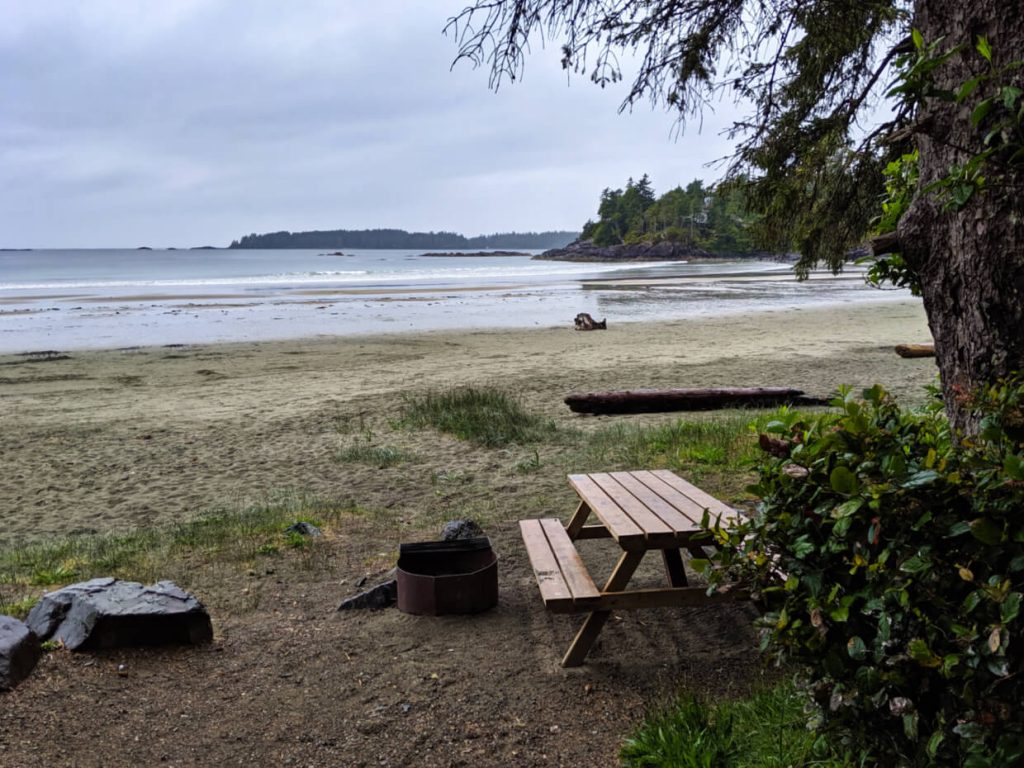
Surf Junction Campground
If you’re looking for a characterful yet relaxing campground near Ucluelet, Surf Junction is likely to be a perfect match.
While not on the ocean (it’s a 2.5km hike away), this campground has plenty else to offer in terms of atmosphere, facilities (there’s a sauna!) and privacy.
Divided into two main camping areas, Surf Junction is an expansive place with the newer forested ‘Back Lot’ offering even more seclusion.
Surf Junction Campground has 75 campsites, ranging from $35-55/night in peak season. Some sites have services (power, water, sewer). The campground has flush and composting toilets, coin operated showers, potable water, store, wi-fi (at the office), hot tub, sauna, surf rentals and a covered picnic area. Campsites can be reserved online.
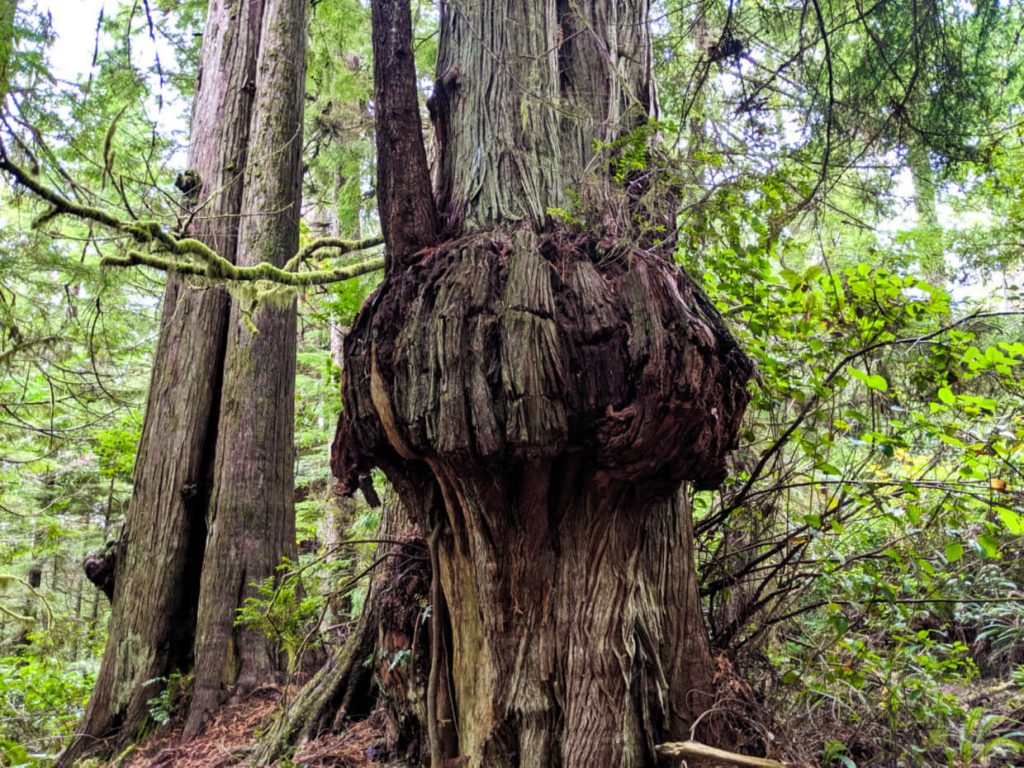
Alder Bay RV Park + Marina
The easiest way to get off the beaten path on Vancouver Island (no gravel roads required) is to head north. This is where the roads get quieter and the scenery gets wilder.
Alder Bay is a very civilised place from which to take it all in – just don’t forget to watch for orca whales as you relax!
More RV-centric than the other recommendations listed here, we still found Alder Bay to be a small van / tent friendly place. There are 12 walk-in (tent) only sites located right on the water.
lder Bay RV Park has over 80 campsites, ranging in price from $28-46/night in peak season. Most of the RV sites have services available (water, power, sewer). The campground has flush toilets, coin operated showers, laundry facilities, pay for use wi-fi, a kayak launching area and a store. Campsites can be reserved online.
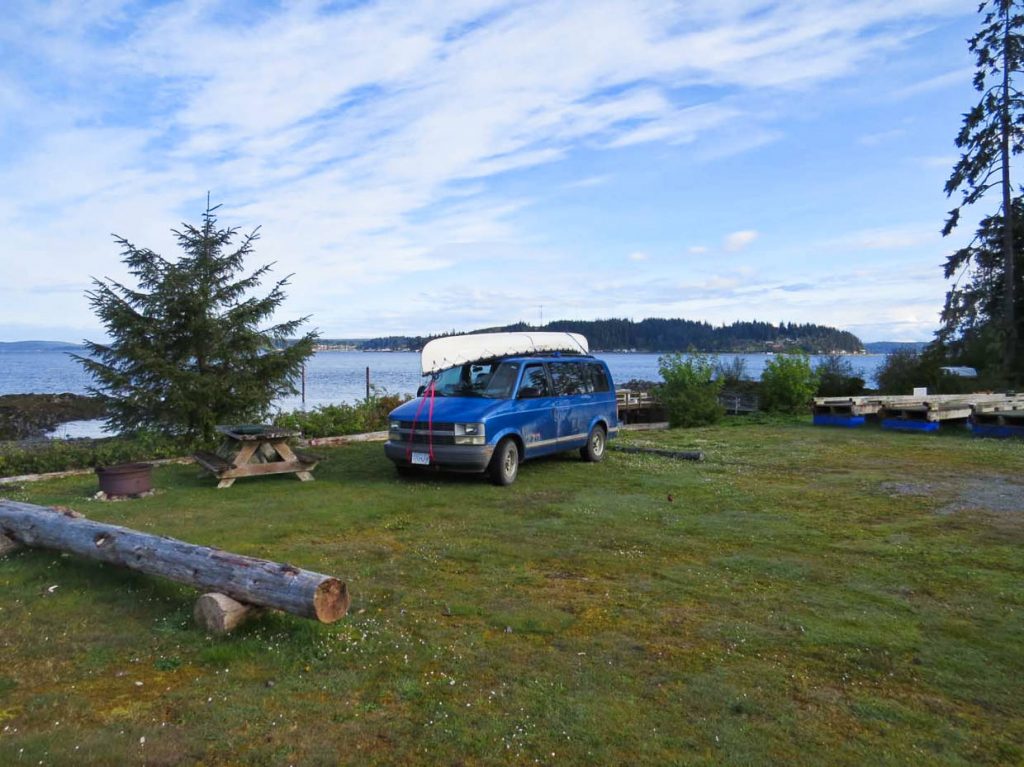
Recreation Sites
British Columbia has an amazing Recreation Site system offering low cost (and often FREE!) rustic camping opportunities.
There is a large network of these on Vancouver Island, especially in the northern region.
Recreation Sites operate a little differently than their provincial park counterparts:
- All sites operate on a first come, first serve system
- Recreation Sites are usually accessed via gravel roads
- There are outhouses (pit toilets) only
- Potable water is not available (bring your own or treat lake/river water)
- Campsites vary widely concerning size and level of privacy offered
- Every site should have a fire pit and a picnic table but these can get moved around by other campers
- Campers must carry out everything they packed in – garbage bins are rare
- Some Recreation Sites are regularly maintained, others are visited very infrequently
- No overnight fee OR low cost overnight fee for maintained Recreation Sites (less than $20, cash only)
With there being so many incredible Recreation Sites on Vancouver Island, I couldn’t possibly list them all.
Instead, I am including a selection of easily accessible campgrounds (i.e. they are all located very close to main roads).
To locate others, your best resources are the Sites and Trails BC website and the Vancouver Island Backroad Mapbook. The latter is not just helpful when choosing Recreation Sites, but also for navigating on the Island’s many logging roads.
Due to most Recreation Sites being accessible from gravel roads only, you’ll need your own vehicle OR rent from a company that allows their vehicles to be driven on these roads. One of these is FarOut Wilderness, a Vancouver Island based company run by adventurous couple Sam and Abbie. Tell them I sent you for a 5% discount off your booking
Lizard Lake Recreation Site
Just twenty minutes drive from Port Renfrew, this Recreation Site is an ideal place from which to search for the biggest trees in the area.
Avatar Grove, home to the gnarliest trees in Canada, is just a short drive away. The Harris Creek Spruce and San Juan Sitka are also very close – click for more info on finding big trees on Vancouver Island.
Lizard Lake Recreation Site itself is shady and has well spaced camping areas. There are two floating docks, providing easy swimming and paddling opportunities. A hiking trail circles tranquil Lizard Lake.
Lizard Lake has 28 vehicle accessible campsites and 4 walk-in (tent only) sites. The fee is $18/night per camping party.
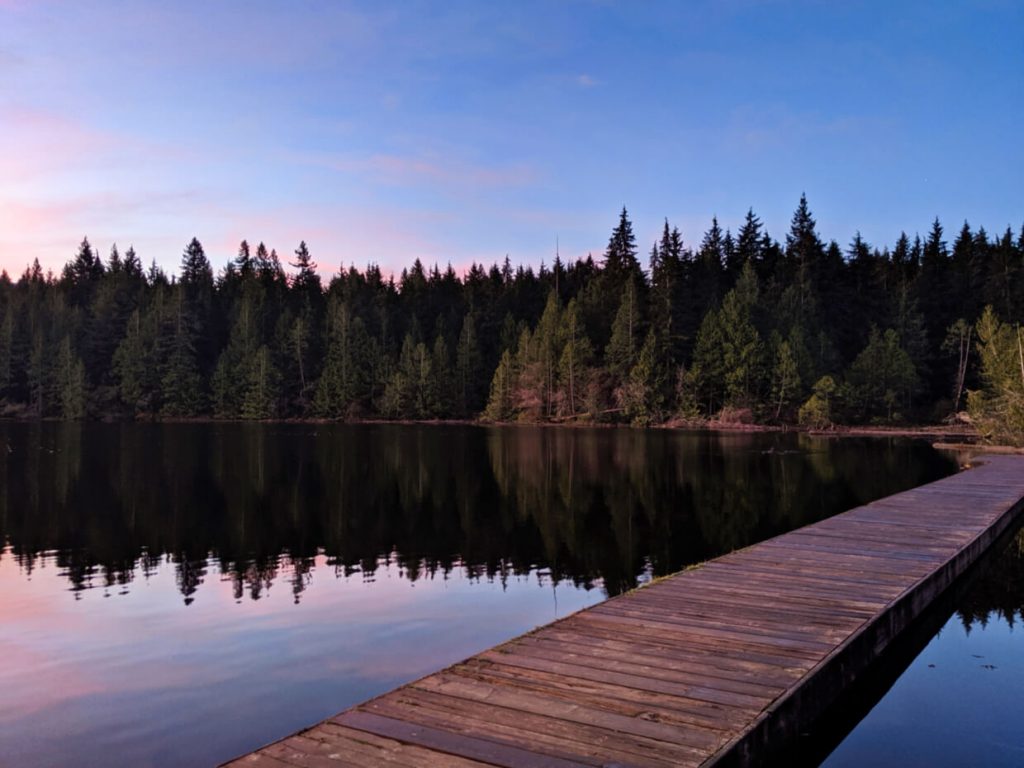
Strathcona Dam (BC Hydro) Campsite
The BC Hydro Recreation Site at Strathcona Dam must be the cleanest and best maintained spot for free camping on Vancouver Island.
Sitting directly below the dam, the location isn’t the most wilderness-like you can find in the area but the waterside sites are surprisingly picturesque.
This campground will be moving sometime in 2020, due to the dam being upgraded.
Strathcona Dam has 11 vehicle accessible campsites as well as a large area for informal camping (perfect for groups). There are garbage bins. Camping here is completely FREE!
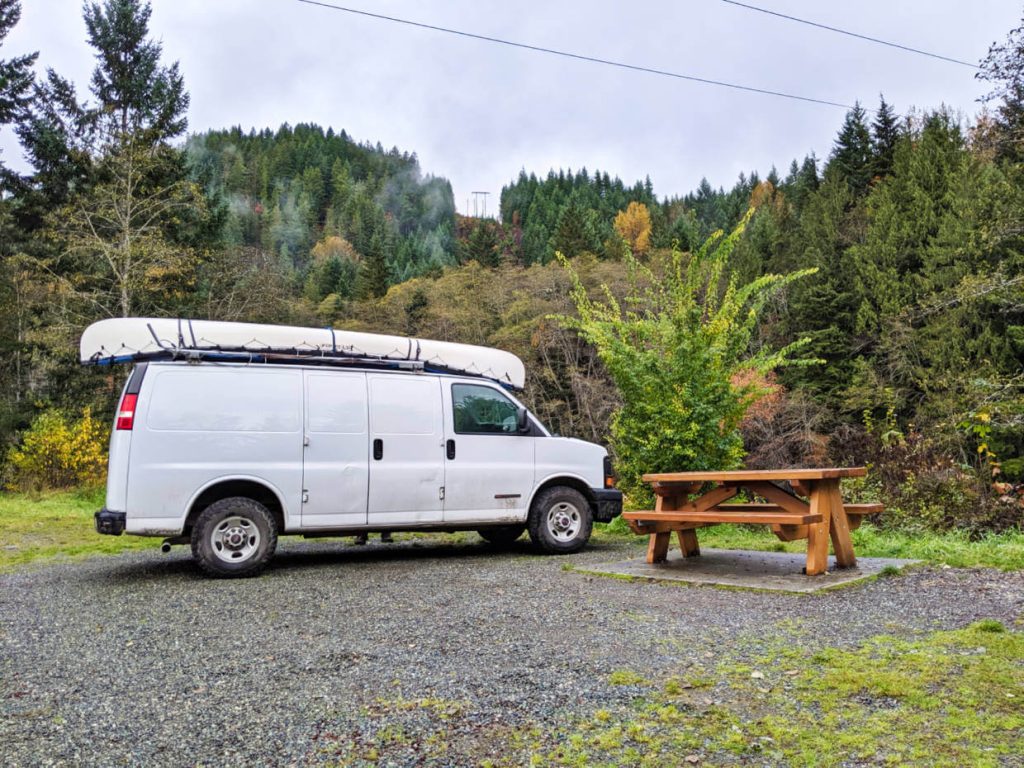
Marble River Recreation Site
Located next to a Provincial Park of the same name, Marble River Recreation Site offers well spaced, mostly private campsites in a forest setting.
The campground is a 40 minute drive from Port McNeill. Accessible both on foot and bike, the nearby Marble River trail is 4.2km long and provides salmon spawning viewing in autumn.
Marble River Recreation Site has 16 vehicle accessible campsites. Camping here is completely FREE!
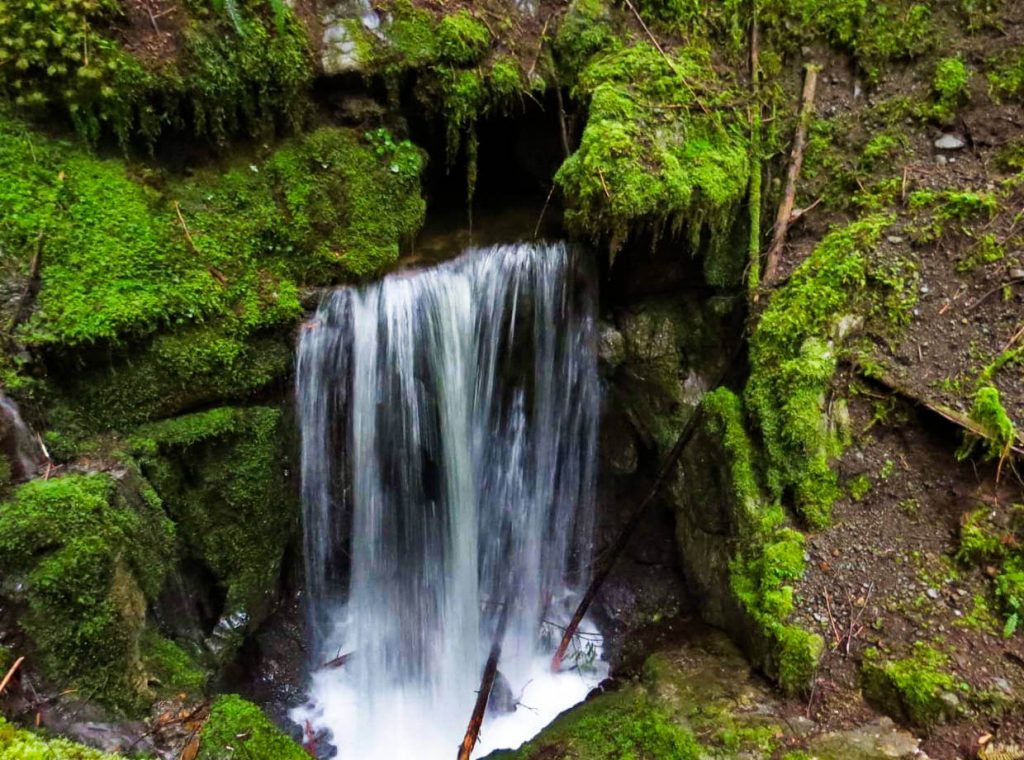
Nahwitti Lake Recreation Site
A small, fairly dark campground perched between a road and a lake, the beauty of this Recreation Site is all in the trees and location.
Huge balsam and hemlock trees reach for the sky, creating an impossibly high canopy about the camping sites. In terms of location, Nahwitti Lake is the perfect stopover on the way to (or from) Cape Scott Provincial Park.
Nahwitti Lake Recreation Site has 8 vehicle accessible campsites. Camping here is completely FREE!
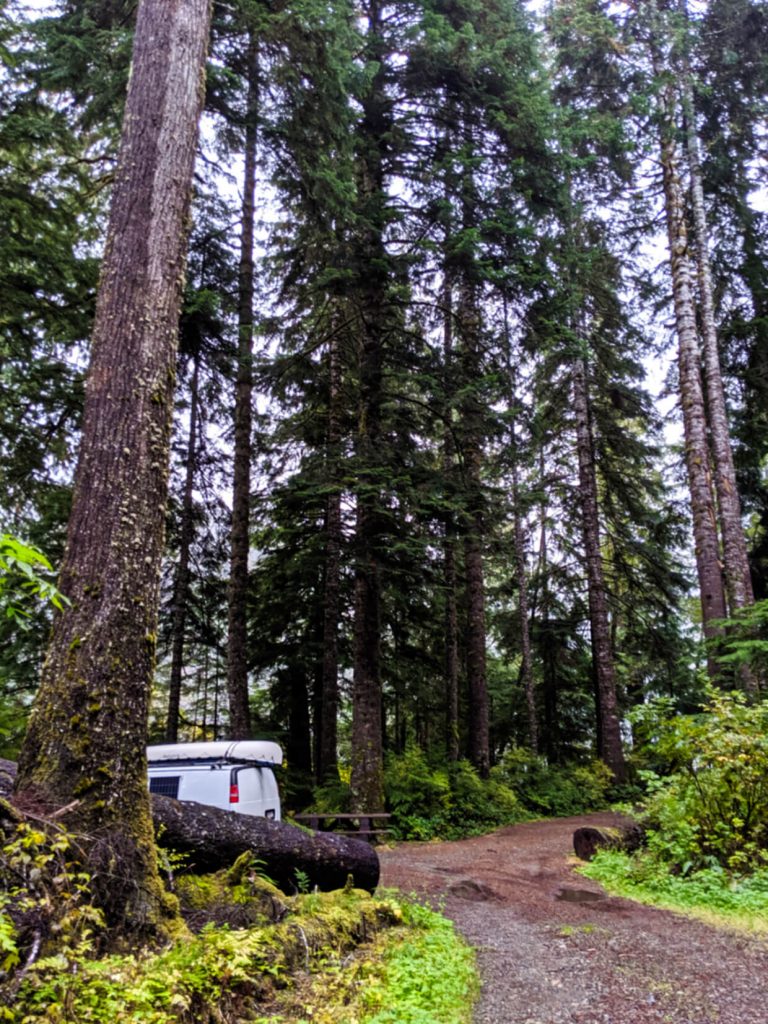
How to secure the perfect Vancouver Island spot
Finding somewhere to go camping on Vancouver Island is a source of stress for many people every summer.
And, of course, camping is meant to be the opposite of frustrating! Making a reservation (which can be an exasperating experience in itself) is the only true guarantee of securing a spot, but I do have tips and advice that may help.
My general Vancouver Island camping guidelines are:
- Avoid holiday weekends (Canada Day, BC Day, Labour Day)
- Go camping on weekdays rather than weekends
- Plan a trip for July rather than August, the latter is the busiest month all year
- Arrive as early as possible – first come, first served ‘check-in’ time at provincial parks is 7am – 10am
- Be prepared to go further. The closer a campground is to the main (or paved) road, the busier it will be
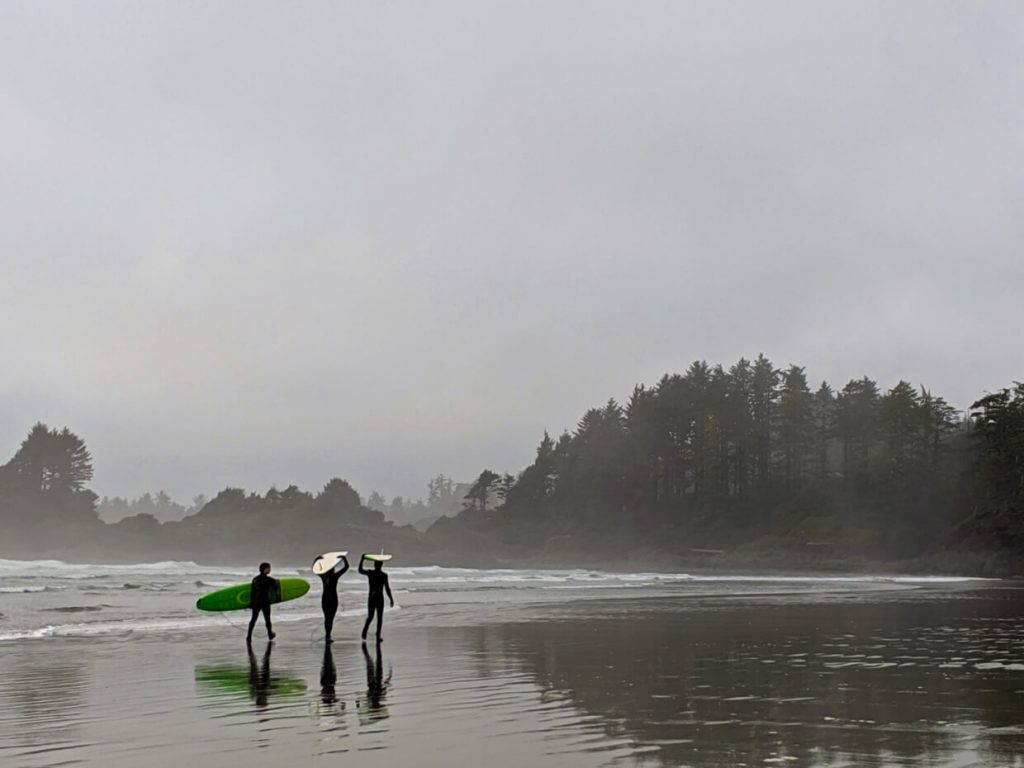
Insider tips
As mentioned, I worked at a large provincial park campground on Vancouver Island for two summer seasons.
With that in mind (plus over 120+ nights of camping across Vancouver Island), here are some insider tips:
- Consider booking a double site with another family or camping group. Double sites at provincial parks (designed to allow two camping parties to camp in close proximity) must be reserved together, so they are less likely to sell out as quickly
- Even if provincial campgrounds appear to be booked solid, it’s worth checking in person for no shows. Reserved sites are held until 11 AM the day after the scheduled arrival date. So if someone doesn’t notify the campground host of a late arrival, their entire reservation will automatically be cancelled the next day
- Bring a tent. Walk-in tent campsites are less popular, so campers who have the flexibility to use a tent are more likely to be able to score a last minute site at provincial campgrounds (if applicable, not all parks have walk-ins)
- If there are only a few spots left on arrival, claim one immediately. You can still swap later if desired (no charge) but hesitation may cost you the possibility of having any camping site!
- September is an awesome time to camp at provincial parks on Vancouver Island. The reservation season ends after the Labour Day holiday, which means that campsites cannot be reserved for dates after this
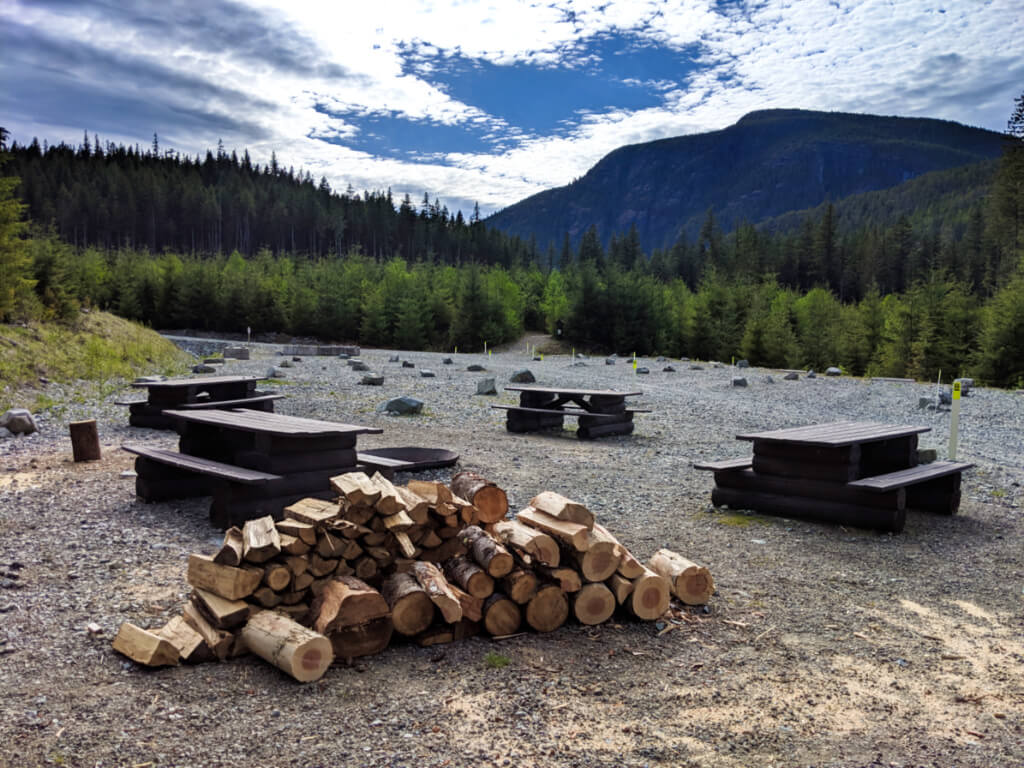
Essential camping items
Don’t forget these must have items when heading out on your Vancouver Island camping trip!
Lightweight tarp – Whether you’re camping in the mountains or temperate rainforest, you can’t go wrong with carrying a lightweight tarp for shelter or shade. Rain is possible at any time of year
Mosquito repellent – The mosquitoes in some areas of Vancouver Island can be vicious, especially in spring. Some kind of repellent is a must. Consider an appliance such as the ThermaCell
Camping stove – Never solely rely on campfires for cooking food. Campfire bans can come in at any time or the wood may be too wet to light properly. Bring a camping stove
Lighting – Always bring a separate source of light, be it a headlamp (hands free!) or lantern. The latter is great for long evenings playing cards or hanging out by the fire
